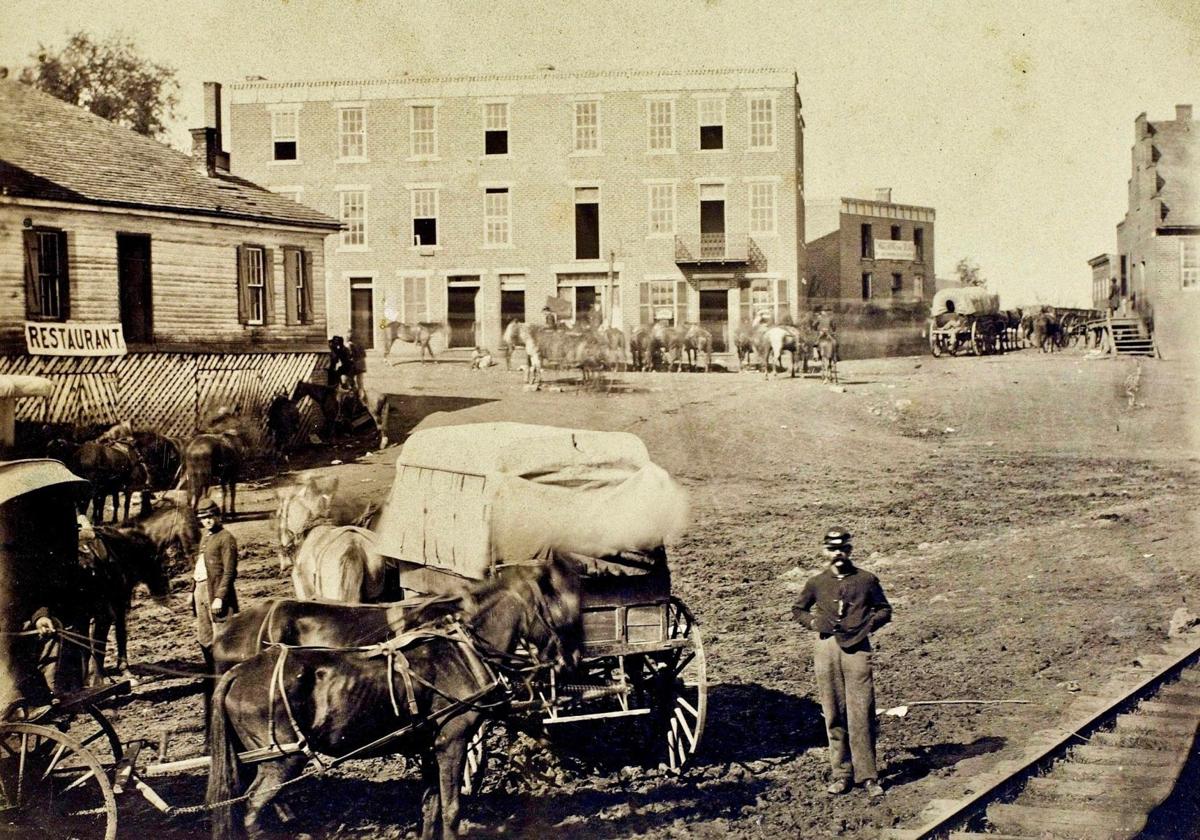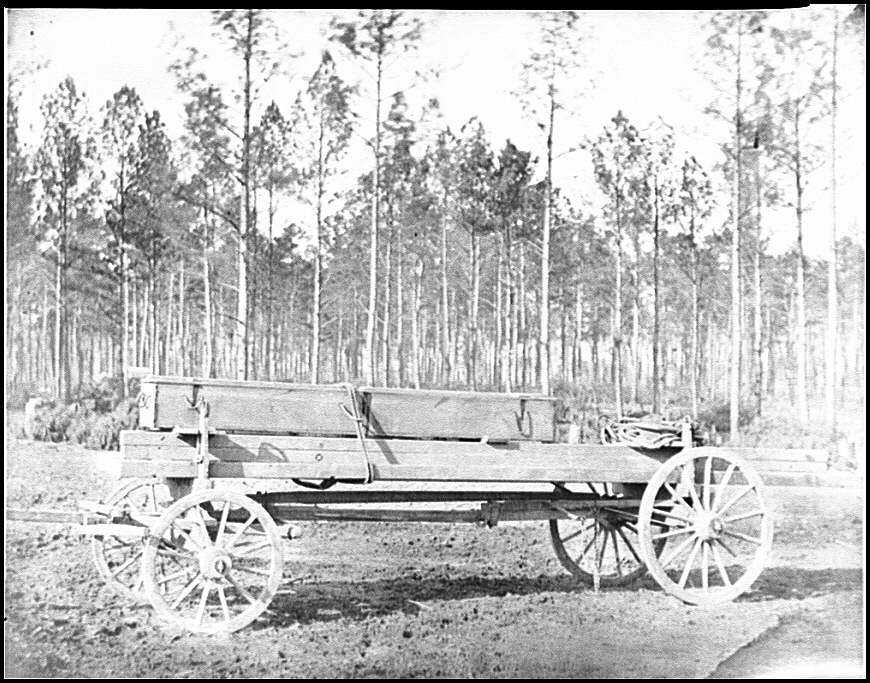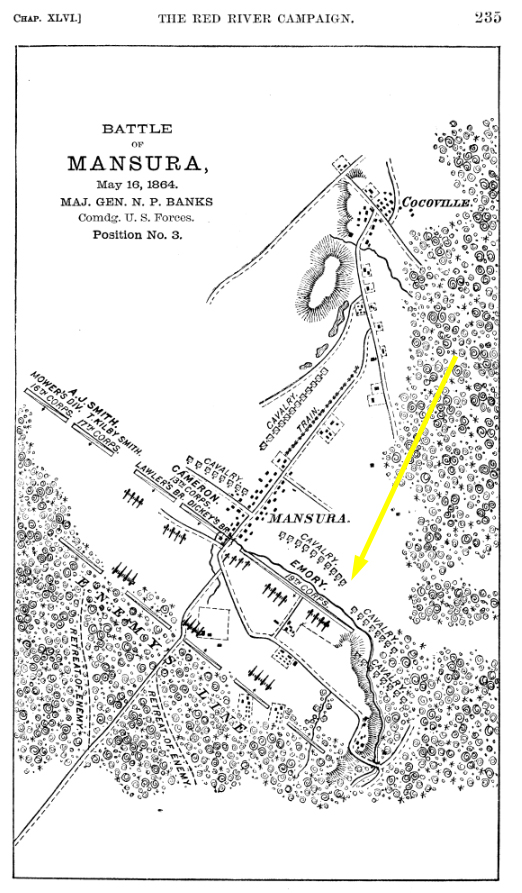The War at the Beginning of 1864
The fate of both brothers Daniel and William Griffis ultimately were swayed by the broad brush Union strategies in the Shenandoah valley and the Teche country in Louisiana. One soldier who fought under Union General Nathaniel P. Banks during the Louisiana campaigns stated “the Teche country was to the war in Louisiana what the Shenandoah valley was to the war in Virginia … there the resemblance ends, for the Teche country is a long flat, hemmed in my marshes and bayous.” [1] Both campaigns would have an impact on the Griffis brothers. Daniel as a wagon master endured the hard physical labor of managing a wagon, mules, supplies, the possibility of being captured or killed on a daily basis through daily skirmishes in the spring and summer of 1864. His younger brother, William, left in the spring of ‘84 for Louisiana to experience war first hand in an environment that was totally foreign to someone growing up in New York. William would come back north and be engaged with the Army of the Potomac within miles of where is brother was also fighting.
Ulysses Grant: A New Vision and Approach to War
Dissatisfied with General Halleck as general in chief and impressed with Grant’s victories in the west, Lincoln appointed Ulysses S. Grant to supersede Halleck and to assume the rank of lieutenant general which Congress had re-created. Leaving Sherman in command in the west, Grant arrived in Washington on March 8, 1864. He was given largely a free hand in developing his grand strategy. He retained Meade in technical command of the Army of the Potomac but Grant effectively assumed direct control by establishing his own field headquarters with the Army of the Potomac. He sought to move this army against Lee in northern Virginia while Sherman marched against confederate General Johnston and Atlanta, Georgia.
However, before Grant had complete control of the Union forces, Lincoln and Halleck had unfinished business in the south and borrowed troops from the northern campaigns to bolster and initiate a strategy to move northwest through Louisiana, following the Red River, up to Shreveport to consolidate control over Texas and Louisiana. Concerned about France’s interference in the affairs of Mexico, Lincoln and Halleck believed the Republic needed to exhibit a strong presence in Texas. At the time, the entire Mississippi River was under Union control.
Grant viewed the initiative in the Louisiana as of little strategic value based on past unsuccessful efforts and compared with his emerging plans to engage in campaigns simultaneously in the east and the west. Halleck’s plans for the Red River campaign were issued prior to Grant’s assumption of his new duties. Halleck ordered Major General Nathanial Banks to establish dominance in Louisiana. Banks commanded the 13th and 19th Army Corps in New Orleans. He had launched two previously unsuccessful efforts in 1863. Grant consequently imposed an April deadline for its completion and the return of troops to Major General William Sherman. Coupled with the strategic rivalry between Halleck, Lincoln and Grant, Banks, a former governor of Massachusetts, viewed his third campaign effort for Texas as potentially a future political stepping stone. [2]
As James Bowen recalls in his history of the First New York Dragoons:
“With the approach of spring 1864, increasing activity in all departments in preparation for the coming campaign, was everywhere apparent… . The ordinance, commissary, and quartermaster’s departments were each in their respective lines busily equipping the cavaliers … . Radical changes were also to be made in the leadership, reorganization, and general management of this important branch of military service.” [3]
The Confederacy used the strategic advantages of the Shenandoah valley so effectively that it often became the “valley of humiliation” for the North. For most of the war, Confederate armies were able to move north through the valley and toward Washington City. Conversely, Union armies advancing south found themselves pushed farther away from Richmond to protect the nation’s capital. When a Southern army crossed the Potomac at its confluence with the Shenandoah River, it cut across the Baltimore and Ohio Railroad and was only 60 miles northwest of Washington. The presence of a Confederate army in the northern part of the Shenandoah Valley was often considered a sufficient menace to justify calling back Union troops from campaigns elsewhere to ensure the security of the capital. [4]
American Battlefield Trust has created a series of animated maps depicting major civil war campaigns and battles. For a high level visual overview of the battles that Daniel Griffis and the First Dragoons were involved with during the Overland Campaign, see the video below.
Confederate General Early’s dominance of the lower valley was a persistent irritant and motivating factor for General Grant’s Shenandoah campaigns. Beyond the agricultural bounty, the strategic benefits of controlling the valley and the boost in morale that a series of Union victories would bring, the success of controlling the valley would affect Abraham Lincoln’s chances for reelection in the November 1864.
Grant’s new vision on how to conduct war in the Valley stressed the use of massive numbers of troops to overcome casualties, constant offensive movements regardless of short term losses, the destruction the Shenandoah agrarian breadbasket that fed the Confederate forces, and the single minded goal to conquer Confederate armies rather than territory. As Gordan Rhea, a noted historian of the Overland Campaign [5], indicated in an interview with the Tattooed Historian and Peter Carmichael, Director, Civil War Institute at Gettysburg College, (see below) the Overland campaign was “an horror show” for the soldiers. For about 40 days they experienced constant marching, fighting in the forested wilderness, and major battles that were one after another with no breaks. It was also during this campaign that the Confederate army started to use earthen fortifications on a consistent basis. By the Battle of Cold Harbor it became an art form. The Confederates started to have engineers figure out in advance based on the contours of the land where to build trenches. They would put stakes out, similar to surveying, to plan and develop fortifications. Each Confederate regiment would create these barriers in a slightly different manner.
Daniel Griffis: With Sheridan in the Shenandoah Valley
In the early battles of the campaign, Sheridan’s cavalry, which included the First Dragoons, was relegated by army commander Major General George Meade to its traditional role of screening, reconnaissance, guarding wagon trains (where Daniel probably was as a wagon master) and rear areas of the regiment. The First New York Dragoon’s use in battle subsequently changed during this campaign where they became the point of the stick in battle.
In the Battle of the Wilderness (May 5–6, 1864), the forested terrain prevented any significant cavalry role. As the army swung around the Confederate right flank in the direction of Spotsylvania Court House, Sheridan’s troopers failed to clear the road from the Wilderness, losing engagements along the Plank Road on May 5th and Todd’s Tavern on May 6th through May 8th, allowing the Confederates to seize the critical crossroads before the Union infantry could arrive. [6]
When Meade quarreled with Sheridan for not performing his duties of screening and reconnaissance as ordered, Sheridan told Meade that he could “whip Stuart” if Meade let him. Meade reported the conversation to Grant, who replied, “Well, he generally knows what he is talking about. Let him start right out and do it.” [7]
“It is proper here to notice that, according to Sheridan, the bloody battles of Todd’s Tavern and Spottsylvania need not have occurred but for Meade’s unwarranted interference with Sheridan’s well-laid plans. It was also in connection with this that the fiery wordy encounter between Meade and Sheridan occurred.” [8]
Meade deferred to Grant’s judgment and issued orders to Sheridan to “proceed against the enemy’s cavalry”. Sheridan Calvary Corps, including the First New York Dragoons, were sent on a raid from May 9 through May 24, toward Richmond, directly challenging the Confederate cavalry.
“In order to have his troops well in hand, Sheridan moved his entire command on a single road. The immense cavalcade, moving in columns of fours, covered a stretch of thirteen miles.” [9]

The raid was less successful than anticipated. Sheridan’s raid managed to mortally wound Confederate cavalry commander Major General J.E.B. Stuart at Yellow Tavern on May 11th and beat Major General Fitzhugh Lee at Meadow Bridge on May 12th. [10]
“The hardest fight thus far of our raid occurred at Yellow Tavern on the 11th. We were about two miles back, when the enemy, from a well-chosen position, opened upon our advance. The sound of the first gun had scarcely reached us before the whole column broke into a gallop, and within ten minutes we wheeled into line of battle. In less that it can be written, Colonel Thorpe’s ringing command was heard; ‘Dismount and prepare to fight on foot! Forward double-quick march!’. The rebel line was scarcely twenty rods away, while a battery was enfilading us, – ‘Hold your fire’, was the understood order; but when about half the distance was covered, word came along the line: ‘Every man shoot to kill.’ At this the boys broke into a yell, and began pumping lead from their deadly seven shooter carbines in that line of grey at such a terrible rate that they broke and ran like a flock of sheep.” [11]
Regarding the raid at Yellow Tavern and the mortal wounding of Jeb Stuart, despite historical accounts to the contrary (notably Custer’s accounting of Stuart’s demise), Captain Leach of the First New York dragoons recalled:
“General Sheridan, coming along our line, asked me if I could reach those buildings and occupy them; see what the Confederates are doing, their number, etc., and if anything special, report him. I took some twenty men, directing them to keep behind the fences so as not to attract attention, while I went up the lane. … While I was viewing their lines, my men called my attention to a ride upon a white horse, evidently an officer of rank, who was riding along their lines, seemingly superintending their formation. One of my men, Shedrick L. Pealer, called my attention to him particularly and said, ‘ I will try him a shot’, and resting his carbine across the corner of one of the huts, elevated the sights, and fired. The officer fell, and created general confusion… and our line moved back into the woods and out of sight. … I afterward learned that Gen. J.E.B. Stuart rode such a horse, and was killed that day, and it was reported through Confederate sources that Stuart was struct by a ‘chance shot’; but I have always believed that it was the shot of Pealer that killed him.” [12]
The First New York Dragoons subsequently had skirmishes at Meadow Bridge and crossed the Chickahominy River at Jones Bridge. They encountered another skirmish at Malvern Hill and then marched nearly 40 miles, having recrossed Chickahominy at Bottom’s bridge to reach Haxall’s Landing. They left there for White House Landing, marching all night and the following day with but one stop.
“During this expedition both men and horses suffered from hunger. Passing over a portion of country repeatedly desolated, no forage could be obtained. This was one of the few instances in which we really suffered from hunger, living four or five days on parched corn. After drawing rations at White House, and another long, dusty march via King William’s Court House, the command rejoined the Potomac Army at Chesterfield Station, May 25. One this raid the corps lost several hundred horses from heat and overwork, the animals dying with what was called the ‘flutters’, probably a violent palpitation of the heart.” [13]
Thumps or flutters, known in the veterinary world as synchronous diaphragmatic flutter [14], is similar to hiccups: a spasm of the diaphragm. However while hiccups are generally harmless for humans, the thumps in horses point to something more harmful. The treatment for thumps is to restore the horse’s electrolyte balance. Calcium is typically the most important electrolyte to replace. The absence of blood calcium is primarily responsible for this malady.

Mules and horses played a fundamental and often times personal role with soldiers in the war. This equestrian statue stands in a small courtyard adjacent to the United States Cavalry Museum at Fort Riley, Kansas. This three-quarter sized statue is dedicated to the million and a half horses and mules that perished or were used during the Civil War. It was dedicated in the summer of 1997. This statue was commissioned by Paul Mellon who served at Fort Riley during World War II and sculpture was designed by Tessa Pullan.
The maintenance of the equine forces during this campaign was staggering and posed constant logistical challenges for the Union army. [15] The ratio of men to equine during this campaign was 1 to 3.
“ … the Army of the Potomac, as near as we can arrive at the figures, appears to have numbered ordinarily about one hundred and twenty-five thousand effective fighting men. Its transportation is reported to have consisted of about four thousand two hundred wagons, eight hundred (800) ambulances, thirty thousand (30,000) artillery, cavalry, ambulance and draught horses, four thousand five hundred (4,500) private horses, and twenty-two (22,000) thousand mules, making an aggregate in all of some fifty-six thousand (56,000) animals. This is just about one-third (1/3) animals to the men.” [16]
Other estimates suggest that by 1863 the army needed half as many horses and mules as there were men in uniform to provide mobility to the armies. [17]
Horses and mules required hay and grain for fuel. To remain healthy, an average 1,000 pound horse required 14 pounds of hay and 12 pounds of grain per day while mules required 3 fewer pounds of grain. Hay provided nutrition and bulk that supported their digestive systems. Grain provided the necessary energy and nutrition for muscles. Horses also needed salt, preferably three times a day. Based on Union operational orders, in the armies operating against Richmond, the maximum allowance of forage per day was ten pounds hay and fourteen pounds of grain for horses. For mules the allowance was ten pounds hay and eleven pounds of grain. When short forage could only be provided, the allowance for horses was fifteen pounds and for mules thirteen pounds. On a march, however, the forage ration was only ten pounds grain. [18]
The Union army employed a method of using hay “presses” to compact palatable grass into 400 pound bales that were efficiently transported by rail and boat to war supply points and then transported by wagon to the troops. Daniel Griffis may have been involved with such transport. [19]
The First New York Dragoons rejoined the main army after being behind rebel lines for weeks. However, the hope for some rest was cut short with ‘five days of awful fighting’ [20] between May 28 to June 1, 1864 at Haw’s Shop, Old Church and Cold Harbor.
The Battle of Haw’s Shop lasted for over seven hours and was the bloodiest cavalry battle since Brandy Station in 1863. It was an unusual battle in comparison to previous cavalry engagements in the east because it was predominately fought by dismounted cavalry, many of which were protected by earthworks. [21] First Dragoons are identified in the map below as part of General Merrit’s reserve guard.
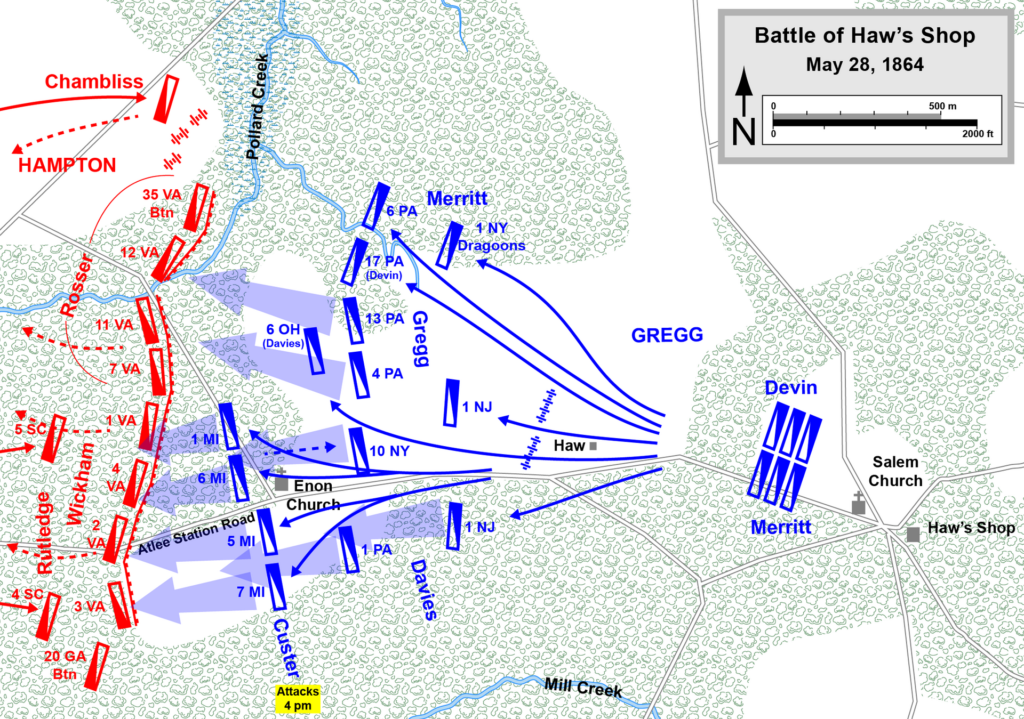
After the battle of Haw’s Shop, the First Dragoons, as part of General Merrit’s reserve guard, moved along with General Devin’s brigade south and engaged Butler’s Confederate troops at Old Church.
“During the afternoon of May 31 the advance on Cold Harbor began, our brigade (the Reserve) taking the lead on the direct road, Devin’s brigade was sent on another road, but for some reason… he failed to carry out his program. We had scarcely gone a half a mile before striking the enemy in force, and at once began the attack, Custer’s brigade deploying on the left of ours.” [22]
The First New York Dragoons proceeded south in pursuit of the Confederate troops towards Old Church and then towards Cold Harbor, as shown in the map below (in the lower right hand corner of the map). Cold Harbor was 10 miles northeast of Richmond, Virginia.
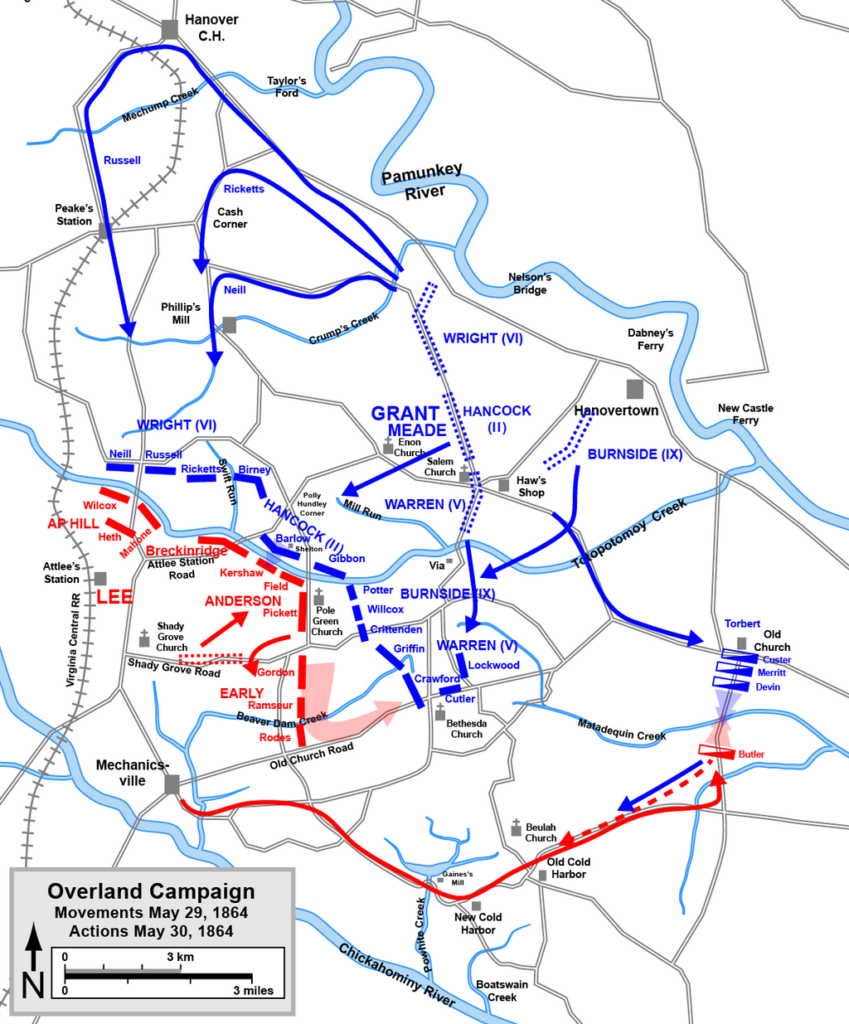
The battles of Cold Harbor, fought from May 31st to June 12th, 1864 were the final battles of Union Lieutenant General Ulysses S. Grant’s Overland Campaign, and the June 3rd battle is remembered as one of American history’s bloodiest battles. Thousands of Union soldiers were killed or wounded in an unsuccessful frontal assault against the fortified positions of Confederate General Robert E. Lee’s army. The First New York Dragoons fought on the first and second engagements at Cold Harbor May 31st and June 1st.
General Merritt, ordered the First and Second U.S. Calvary to detour from Cold Harbor due to the Confederate entrenchments. The First New York Dragoons and the Sixth Pennsylvania calvary occupied their attention to the front line and were ordered to take the hill which was part of the Bloody Run. They “went up the hill and up to the breastworks, pouring an irresistible fire into their ranks. As our boys leaped over, there were many hand-to-hand struggles“. [23] The Dragoons encountered 35 of their troops killed, wounded or missing.
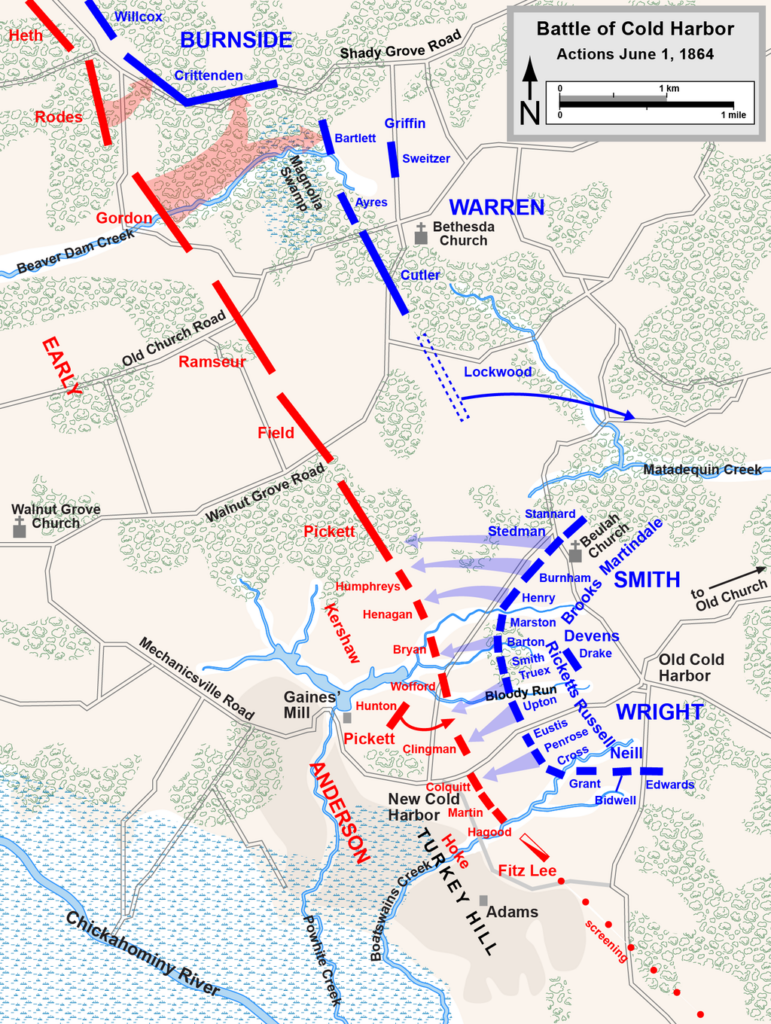
After Cold Harbor, the combined forces of Union cavalry under Sheridan fought against Confederate cavalry under Major Generals Wade Hampton and Fitzhugh Lee in the bloodiest and largest all-cavalry battle of the war at Trevilian Station. The First New York Dragoon regiment lost 16 of their troops, 61 were wounded 8 were missing after the battle. Daniel Griffis was possibly part of the wagon train assistance in this battle, providing munitions or medical aid.
“Sheridan’s forces consisted of two calvary divisions – Gregg’s and Torbet’s – numbering about six thousand officers and men, provided with three day’s rations and forty rounds of ammunition, besides reserve ammunition in wagons; also one medical wagon and eight ambulances.” [24]
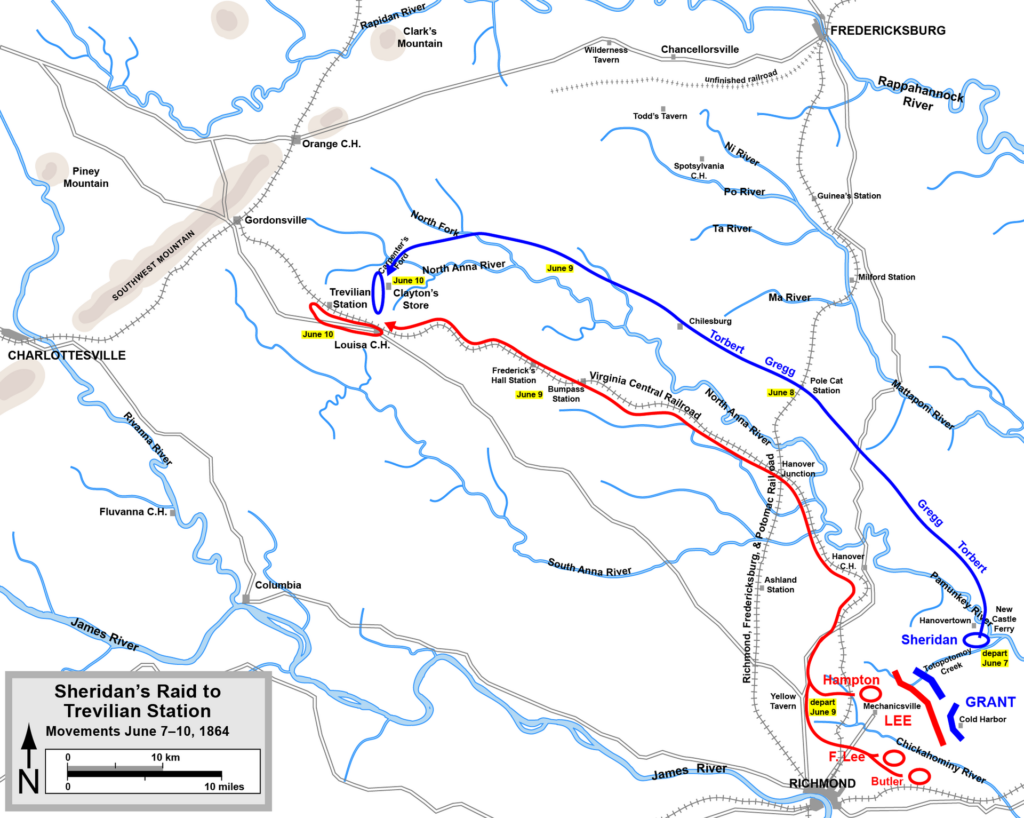
The Dragoons had two engagements at Trevilian Station and for the next 9 days traversed the countryside. Mention is made in regimental memoirs of the long wagon train associated with this campaign.
“Our arrival at White House Landing, June 20, virtually terminated the Trevilian raid, but gave neither the jaded horses nor feared men any respite whatever from severe service, as there was at that place an immense train of about one thousand wagons, which Sheridan was directed to conduct across the James River with greatest possible dispatch. This was no easy undertaking, as the enemy made strong demonstrations for its capture.” [25]
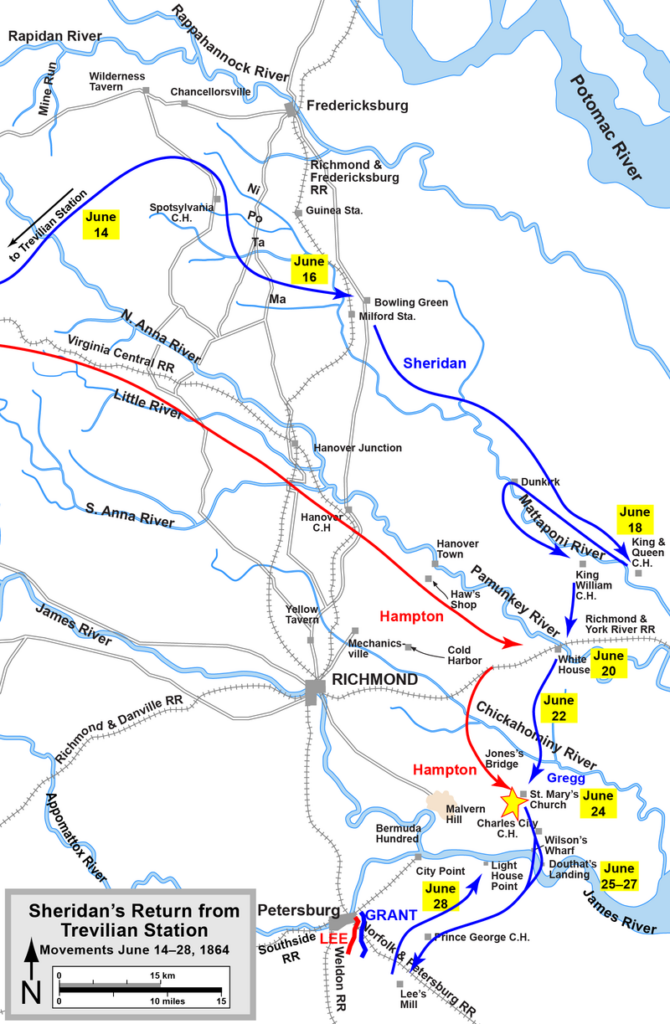
The vast wagon train and troops moved south, crossing the Chickahominy River at Jone’s Bridge and moved on to Charles City. They were constantly in their saddles and encountered skirmishes along the way. They reached the James River and crossed by ferry at Douthart’s landing. At the end of June they rejoined the Army of the Potomac and reached Prince George Courthouse and set up camp at City (Lighthouse) Point on the James River to rest and recruit both men and horses. During this ‘rebuilding’ they nevertheless had reconnaissance forays, a skirmish and an engagement at Darbytown.
General Sheridan stated:
“My command was now greatly reduced: it had been marching and fighting for fifty consecutive days, had marched over eight hundred miles exclusive of side issues – going for rations, going and coming from picket, etc. This fatiguing service had told so fearfully on my animals that the number dismounted men was large. My losses resulting from these wearing marches of the past two months were so obvious that my needs could no longer be neglected.” [26]
Most of the horses were suffering from large saddle sores on their backs and their ribs were showing. They remained at camp from July 2nd to the 26th. During this time, the corps received 1,500 horses and many of the dismounted men returned for calvary duty.
The Dragoons were back in the saddle again and on July 27th crossed the Appomattox River at Broadway Landing and moved north, crossing the James River at Deep Bottom and on the 28th engaged in a skirmish of Darbytown. From there they marched to Petersburg. On August 1st, 1863, the regiment took a transport, moving out of City Point, for Washington. They left Washington on August 6th, marched via Georgetown, Rockville, Clarksburg, Monocacy Bridge, Sandy Hook, and finally to Harper’s Ferry.
“Our march from Washington was wearisome, making forty miles yesterday; but the wearisomeness was greatly mitigated by the hearty greetings we received all through Maryland. All along the journey the people greeted us with waving handkerchiefs and cheers, women and girls were by the roadside with pails of cool water and one man had several large baskets of harvest apples which he tossed to us.” [27]
“Our entrance upon the Valley campaign was signalized as the entrance also upon our third year’s service. Two for the First New York Dragoons as honorable record. Since the opening of the spring campaign it has participated in fourteen hard fought battles, besides numerous minor engagements. It had repeatedly marched with unfaltering tread into the very jaws of death. Nearly half the brave boys who started out with us three months before, had either fallen in battle, were suffering in hospitals, or worse than all, were slowly dying of starvation and inhuman treatment in those terrible Golgothas, known as Confederate prisons.”[28]
With his usual determination and focus, Sheridan began preparations for an aggressive campaign in August, one that would have life changing impacts on Daniel Griffis.
William Griffis Heads South for the Red River Campaign
Scarcely back from his medical furlough at home, William Griffis and the 153rd New York Volunteers received orders to move at moment’s notice [29]:
February 16th 1864
No guards will be relieved until further orders from HeadQuarters. The men will be provided with haversacks, canteens & knapsacks complete. Company commanders will make immediate requisitions for all deficiencies in clothing &c. The men will carry with them their dress clothing & blouses. Company Commanders will immediately report how many men they can take with them & draw the necessary arms & equipments for all recruits.
By order of Edwin P. Davis, Colonel
On the 17th of February, the 153rd regiment received orders to march to Alexandria, Virginia on February 18, 1864 to embark on a steamship at 5:00 pm. They experienced a delay and, as directed, the regiment stayed at the Soldier’s Rest in Alexandria for two nights prior to departure.. Additional orders advised that the regiment would embark on the steam ship Mississippi. Companies A (William’s company), F, D and G were to occupy the lower bunks, lower deck. Five men were to populate each bunk. The officers were advised to ensure their men were properly provided for and no more room is used than what is needed. Companies I, H (Sarah Rosetta Wakeman’s company), E, K, G and B were to occupy the upper bunks, upper deck. The entire regiment was to occupy the forward part of the deck. [30]
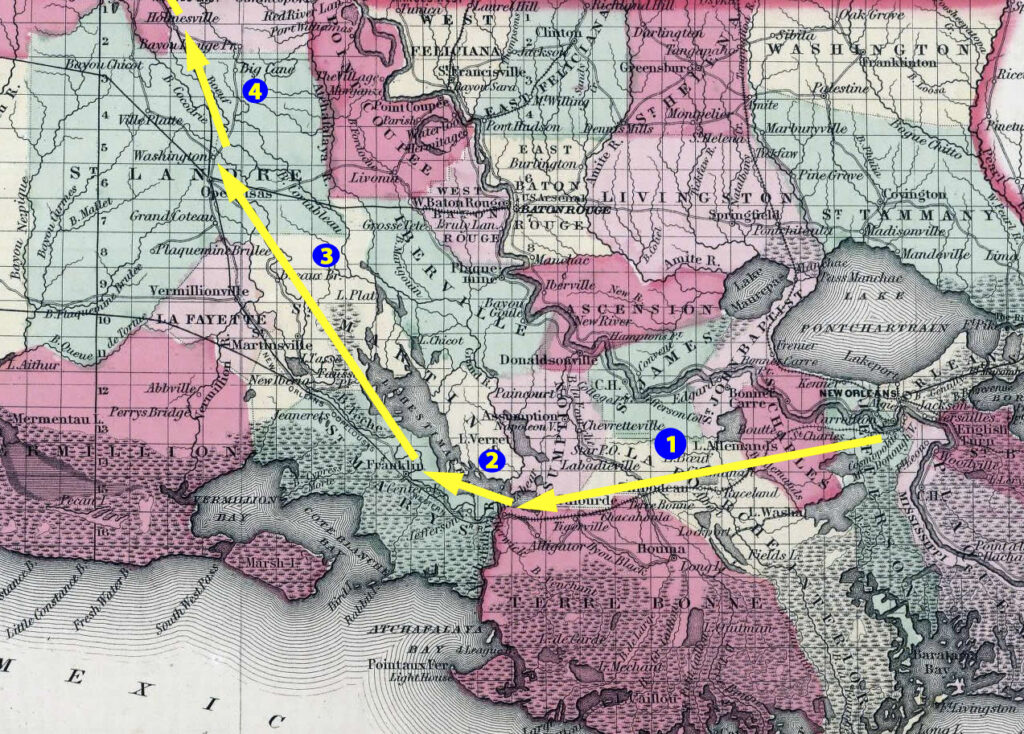
The steamship departed on February 20, 1864 for a nineteen day voyage to Algiers, Louisiana, just across the Mississippi River from New Orleans. At the beginning of March, the regiment traveled from Algiers by rail to Brashear City (Number One Blue Dot on the map above). They then marched 53 miles to Franklin, Louisiana (Number 2 Blue Dot).
At Franklin they were assigned to the veteran First Brigade commanded by Brigadier General William Dwight; First Division commanded by Brigadier General William Emory; 19th Army Corps under Brigadier General William Franklin; Department of the Gulf. The 19th Army Corps, accompanied by the 13th Army Corps and a division of calvary began their combined journey up the Bayou Teche.
On March 15th, 1864, the army set out for Shreveport, making their way to Washington, Louisiana (Number 3 Blue Dot above). The army stopped at Washington after covering 80 miles in five days.
On March 21st, 1864 the army marched onward and camped at Holmesville on March 22nd (Number 4 Blue Dot above). As Ellias Pellet recalled in his history of the 114th Regiment, New York State Volunteers, a regiment that was attached with the 153rd in the First Brigade:
“On the evening of this day bivouacked at Holmesville, on the Upper Boeuf. The country grows higher and better – more like our northern land. Sugar mills are becoming rare, and cotton gins frequent.”[31]
It was during the long marches between March 15th to April 1, 1864 that William Griffis succumbed to heat stroke. Depending on who recalled the event, William may have developed heat stroke around March 16, 1864 near New Iberia, Louisiana or around April 1, 1864. As William’s first Lieutenant John Brownell stated in a pension request affidavit on September 3, 1883:
“… on or about the 16th day of March 1864 near New Iberia La during a very warm day he (Brownell) then said the claimant (William Griffis) while in line was taken suddenly seriously ill and fell from the ranks as desponent (sic) was at the time informed (he not being present just at that moment) saw claimant in a few moments thereafter in an ambulance looking very pale & seemed to be very much exhausted . That from that time on to the time of his discharge was not able to do the full duty of an able bodied soldier. That at times he would seem to be nearly well & then would be taken suddenly ill & be sent to the hospital or if on a march would be put in an ambulance.” [32]
On the 17th the army marched 16 miles to Vermilion Bayou which they reached at 3 pm and camped by the stream. The remainder of the day and night was spent building a bridge over the bayou, the third time the engineers of the 114th completed a bridge over this water. The troops resumed their march at 6 o’clock the next day and passed through Vermilionville towards Carrioncrow Bayou. “For six times, by starlight or beneath the burning rays of the sun“, the veteran troops of the 114th had traversed this road on prior campaigns. [33] For others it was a baptism of marching in the Louisiana heat.
The 114th NY Volunteers, which were part of William Griffis’ brigade, had more experience marching and fighting in Louisiana. [34] In November, 1962, when William’s regiment was performing provost guard duty, the 114th sailed for New Orleans as part of one of General Banks’ earlier Louisiana expeditions. It was stationed for a time at Brashear City and neighboring points, and was first engaged at Fort Bisland, Louisiana. These soldiers were adapted to the heat and conditions of Louisiana and had a disdainful view of their Union comrades that were new to the environmental demands of the south.
Another personal account from a soldier in the companion 114th regiment supports Lieutenant Brownell’s recollections of when William Griffis suffered heat stroke.
The March 18th “march of nineteen miles was one of great severity and fatigue, and caused much straggling among the newly enlisted Regiments, that were making their first campaign. It was painful to witness the young and pale-faced recruits, whose stiffened limbs and blistered feet could scarcely drag their tired bodies along. They appeared, however, to attract little sympathy from the old campaigners. Whenever a column passed by a squad of weary and disconsolate looking stragglers, the poor fellows would be greeted with such shouts as these: “Say, ain’t you sorry you came a soldiering, for nine hundred and a c-a-o-w?’ “Hurry up there. Old Limpy, we’ve got to march eleven miles further to-day,’ ‘ Here’s where you get the worth of your bounty money.’ Hundreds of knapsacks, filled with valuable clothing, were thrown away by the side of the road. These our men eagerly appropriated for their own use…” [35]
Another soldier of the 114th, remembered a long and hot day of marching March 29, 1864: “During our terrible march to-day under the hot sun which seems to scorch with all the fury of its concentrated rays, many of the men of the regiments, new in the campaign, although claiming to be ‘veterans’, fell out by the wayside totally unable to proceed. Some of them had thrown away their knapsacks and blankets, and even then unable to keep up, sunk down overpowered and overcome. Two years ago the men of our regiment would have sympathized with these sufferers, but now they passed them with all manner of ribald jests, laughing at their veteran stripes and ridiculing their fatigue.“[36]
“To a stranger passing along the line of our regiment it would be hard for him to decide what regiment it was, our men had so thoroughly supplied themselves with the new “four dollar knapsacks”, which these other regiments had thrown away – for there were more wearing numbers Twenty-Ninth Maine, Thirtieth Maine, and One Hundred and Fifty-Third New York than of the regiment to which they really belonged.” [37]
Soldiers on both sides grappled with a common enemy: heat-related illness brought on by the blazing sun. Although many of the soldiers were accustomed to the outdoor elements as farmers or laborers, the demands of war made prolonged exposure to the sun far more dangerous. Civil war soldiers became vulnerable to heat related ailments due to long days of marching under heavy packs and wearing woolen clothing that were not conducive to evaporation. [38] In addition, inadequate hydration and the soldier’s typical diet did not help with heat related ailments. The unreliability of water sources on long marches and the limited size of army canteens (usually 32 ounces) contributed to dehydration. Even if a soldier ate half of the daily rations purportedly given to them, their diet lacked vegetables, a major source of minerals which can be depleted during strenuous activity in heat. [39]
The most common affliction was heat exhaustion, brought on when the body can no longer dissipate enough heat to avoid dehydration and electrolyte abnormalities. A second more serious condition is heat stroke which occurs when prolonged exposure causes the body’s methods for regulating temperature to break down. The remedy for heat exhaustion is usually to cease activity and allow the body to cool down. Heat stroke can cause the death of organs such as the kidneys lungs and brain. Even if one recovers, the damaged internal organs do not function properly, often leaving the survivor disabled. [40]
“It should not be supposed that soldiers upon a march are compelled to observe the regular cadence of step, and move in all the precision of a drill or a parade. On the contrary, the men are allowed to adopt whatever gait they may choose, carry their guns and equipments in any position most conductive to ease, converse, or shout as much as they please, and in fact are subject to one restriction, and that is they must keep their relative places in the line. If a soldier is taken sick, he can easily secure a card from his Surgeon, who always rides in the rear of his Regiment, if his complaint on investigation proves to be genuine. Whenever, the ambulance train may come along, this card is a voucher to the ambulance officer that the bearer is entitled to a ride.” [41]
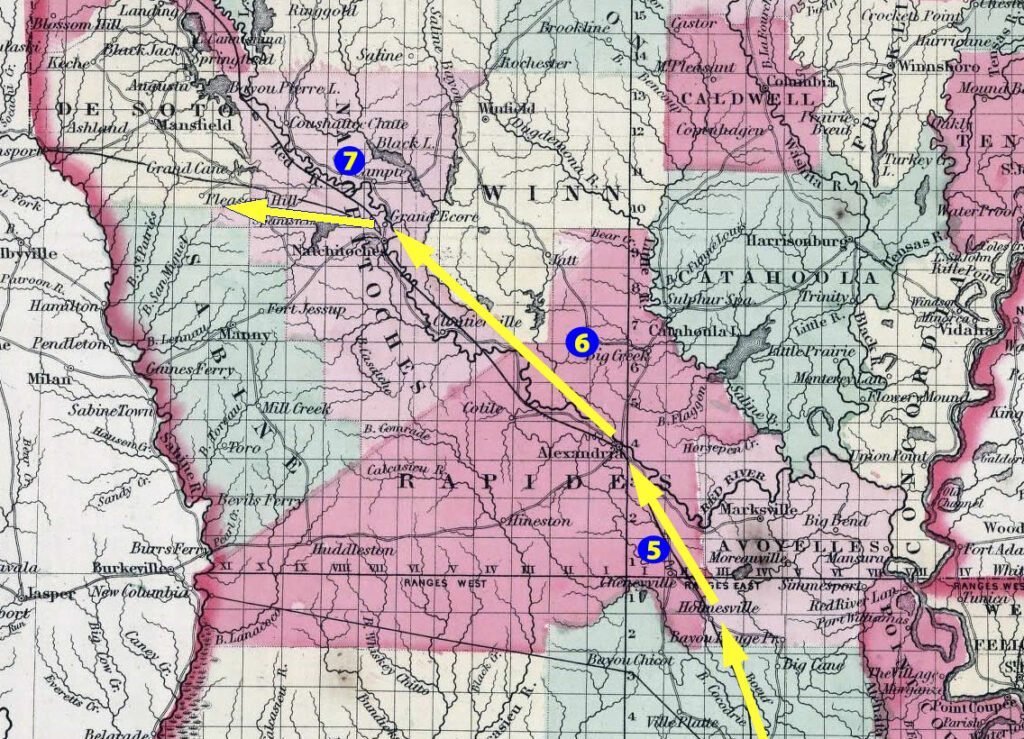
From Holmesville, Louisiana, Banks’ army marched 15 miles on March 23rd to Cheneyville and the following day continued their march 18 miles before they slept in the rain on the grounds of the Wells plantation on the March 24th.
Up to this point the army has yet to encounter any confederate forces. They learned at this point that Brigadier General Smith’s troops had captured Fort De Russy leaving Alexandria open to the Union Army. On the 25th the army reached Alexandria and marched down main street in review of General Banks. The army camped north of town by the Bayou Rapides and stayed here for two days (Number 5 Blue Dot on the map below).
“At just twelve o’clock, noon, we marched into the city with all ‘the pomp and circumstance of glorious war’. General Banks, Franklin, Emory, Smith Mower, and staffs, reviewed us as we passed, amid the huzzas of the men. The inhabitants, unwilling spectators of the scene, looked on in grave silence. We passed through the city, and bivouacked half a mile beyond.”[42]
Alexandria is situated on the Red River about 350 miles from New Orleans. High bluffs overlook the river. When the 153rd arrived in Alexandria, there were about 70 Union river steamboats and a dozen iron clads stretched along the levee. The naval contingent carried food and ammunition for the army. Their forces were now consolidated for their expedition to Shreveport with Alexandria as their base.
The entire force was estimated at 45,000 troops, including the naval contingent, the 16th Army Corps and the 17th Army Corps. Brigadier General William Dwight assumed command of William Griffis’ Brigade which consisted of the 29th Maine regiment, 114th New York regiment, 116th New York regiment , the 153rd and 161st New York Volunteers.
On March 28th, the 19th Corps marched northward along the Red River (Number 6 Blue Dot on the map above). The Corps commenced their march at 10 am. The roads were bad and the army wagon trains moved slowly. Their march took them from the flat, gulf countryside to the “Piney Woods”, heavily pined woods with rugged hills which contrasted from the Louisiana low lands. These woods extended over a 75 square mile tract of land. The troops were off of the river and and into the dry brush area. On March 29th , it was very dusty and dry. the marches were ‘almost unendurable from the dust, which was six inches deep“. [43] On March 31st, they marched again to the Cane River and halted to lay out a pontoon bridge.
“A pontoon train is an important auxiliary to the movements of an army in a country so interspersed with bayous as Louisiana. Our train consists of a great number of large, heavy wagons, which to the causal observer would appear to be laden with lumber. … The ‘lumber” is so nicely fitted that it can be, in a few moments, put together – forming boats – the length of which may be fifteen feet. These boats are anchored in the stream, lengthwise , and planking, likewise transported in the train, is placed on the boats forming a good and substantial bridge. the rapidity with which a stream can thus be made passible for troops and trains is surprising. Its object gained, it is as quickly taken up and replaced on the wagons.” [45]
Another 18 mile march on April 1 took the army across the Cane River again and the next day they arrived at Natchitoches and five miles beyond the town at Grand Ecore Landing they camped. (Number 6 Blue Dot on the map above).
Battle of Pleasant Hill
With the combined forces of the 16th and 17th Corps of approximately 45,000 troops and Admiral Porter’s fleet of gunboats, Banks anticipated marching another 90 miles to Shreveport to establish a presence and return General Smith’s troops to General Sherman for General Grant’s spring offensive. On April 6th, the troops marched 18 miles to Pleasant Hill. (Number 7 Blue Dot on the map above). On April 8th, the 13th Corps passed in front of the 19th Corps on a long narrow road and the 19th bivouacked in a clearing by the side of the road. [46] The calvary as continued northward as the vanguard. At Mansfield, Louisiana, the Confederate troops under the son of former President Zachary Taylor, Major General Richard Taylor, attacked the Union calvary who were part of the long marching train of troops.
The calvary under Gen’l Lee, after driving the enemy from Pleasant Hill, had pushed on after them … early on the morning of the 8th, they proceeded on their way, but, within four miles of Mansfield … . Just at this point the road runs through a dense wood emerging into a large prairie miles in extent. With very little caution Gen’l Lee permitted his wagon train to follow the column so closely that when he reached this open field the train was within the wood. Here a large body of the enemy was found, who opened upon them so unexpectedly, and with such fury, as to make the holding of their position impossible. … The road being blocked up by the wagon train, and it being impossible to turn the crazy mules and frantic drivers, Nimb’s Sixth Mass, and the Chicago mercantile batteries, together with the supply train, were captured. [47]
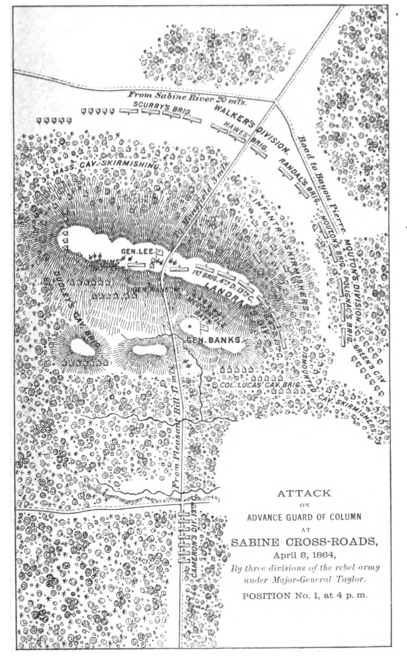
The 13th Crops were ordered to support the calvary but the number of confederate troops made their attempts useless. At the start of the battle, Taylor had approximately 9,000 troops. He had also called on the 5,000 men in the divisions of Brigadier General Thomas J. Churchill and Brigadier General Mosby M. Parsons that had been encamped near Keachi, between Mansfield and Shreveport. These troops arrived late in the afternoon, after the battle had commenced. The 13th Corps retreated and fled down the narrow road from where they originally came. The 19th Corps was ordered forward and formed a line of battle and halted Taylor’s attack (Click on Map on left for larger view [48]
The 153rd New York volunteers were detached from the First Brigade during this battle to relieve the 30th Maine volunteers and to guard the supply train in the rear.
The First Brigade, General Dwight, formed the front line, the One Hundred and Fourteenth being in the centre, the One Hundred and Sixteenth upon the right, the Twenty-Ninth Maine upon the left, the One Hundred and Fifty-Third having been left to guard the train. [49]
With no further advances by the Confederate troops, the 153rd rejoined the 19th Corp and retreated and arrived in the early morning on April 9th back at Pleasant Hill to create a defensive position against the Confederates.
The following maps from the Official Records of the Civil War provide an illustration of where William Griffis and the 153rd NY volunteers were during the Battle of Pleasant Hill [50]. The 19th Corps was ordered to create a line of defense to anticipate follow up attacks. The 153rd NY volunteers were stationed with General Dwight’s command (map below Page 230). Under the command of General Emory, the 19th Corps made a slow retreat up the slope of Pleasant Hill when the Confederates attacked around 4:30 in the afternoon. The Confederates emerged as two advancing lines over the crest of the hill. Union forces attacked from the rear of the Confederate’s advance and the 19th Corps was ordered to attack and rush the enemy lines. The confederates started to flee and the Union troops continued their pursuit and recaptured their artillery that was originally taken from the 13th Corps the day before and captured 500 Confederate prisoners.
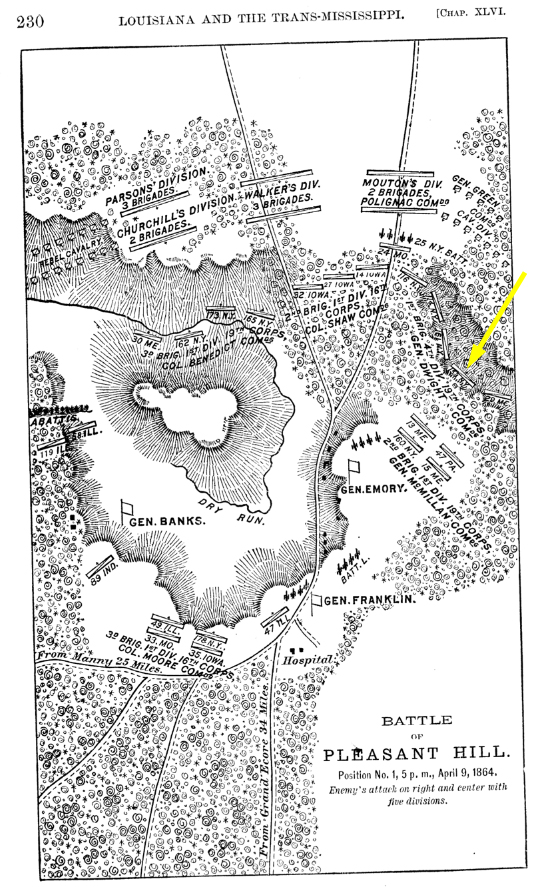

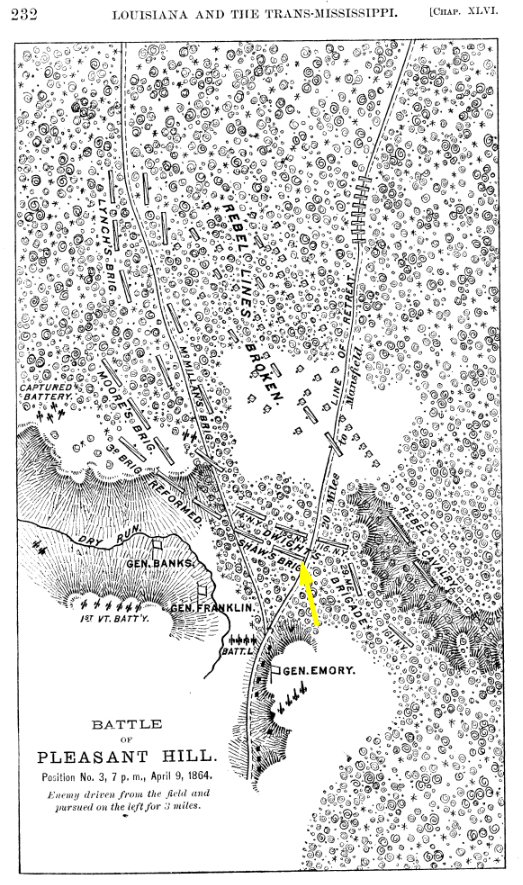
The fighting ended in darkness. The 153rd regiment with the 19th Corps stayed their ground and spend that evening listening to the wounded and dying on the battlefield beyond their picket line.
“There is scarcely a soldier but that would prefer the honest engagement rather than spend such a night amid such scenes as we witnessed on the 9th of April… . Our Brigade behaved splendidly, and the One Hundred and Fifty-Third, which has never before been under fire, won much credit to itself by the steady and decisive manner in which it delivered its fire on the enemy.” [51]
The battle of Pleasant Hill was more severe in its character than the contest the day before, since the whole army – all its Divisions, Brigades and Regiments – were engaged. It was a close hand-to-hand contest, in which artillery could be little used. It was in fact a succession of charges and counter-charges. [52]
The Strategic Retreat Back to the Mississippi
The army had depleted its supply of food, munitions, water and supply trains were not within reach. At midnight on April 9th, orders were received to fall back to Grand Ecore on the Red River. The 153rd regiment arrived at Grand Ecore on April 11th, after three days and and nights with no rest and little food, marching over 50 miles.
“A most decided victory had been gained; the disgrace of the night before had been wiped out, and a desire to follow the retreating enemy at once, or at least in the morning, was uppermost in all our hearts. But our haversacks were empty, and hungry stomachs demanded rations. What could we do without them, and they were miles in the rear hastening back to Grand Encore?” [53]
General Banks’ army went into bivouac at Grand Ecore and rested and resupplied for 10 days. Despite wanting to continue his campaign, General Banks was beyond the agreed upon deadline to return Brigidier General Smith’s troops to General Sherman. Admiral Porter’s fleet was also in danger of being grounded since the water level in the Red River was falling. A final card that forced Banks’ hand to fold was the command’s discovery on April 20th that Confederate General Taylor’s troops had gotten around to Banks’ rear down the river. They needed to retreat.
The retreat began April 21st at 10 in the evening. The troops marched until dawn and throughout the next day for 35 miles.
It was a terrible march, trying to the utmost the endurance of every man. Scores were unable to keep up, and with utter disregard of life, they fell out of the column unable to move further. One man belonging to the One Hundred and Fourteenth N.Y. Vols., dropped dead on that march from exhaustion. [54]
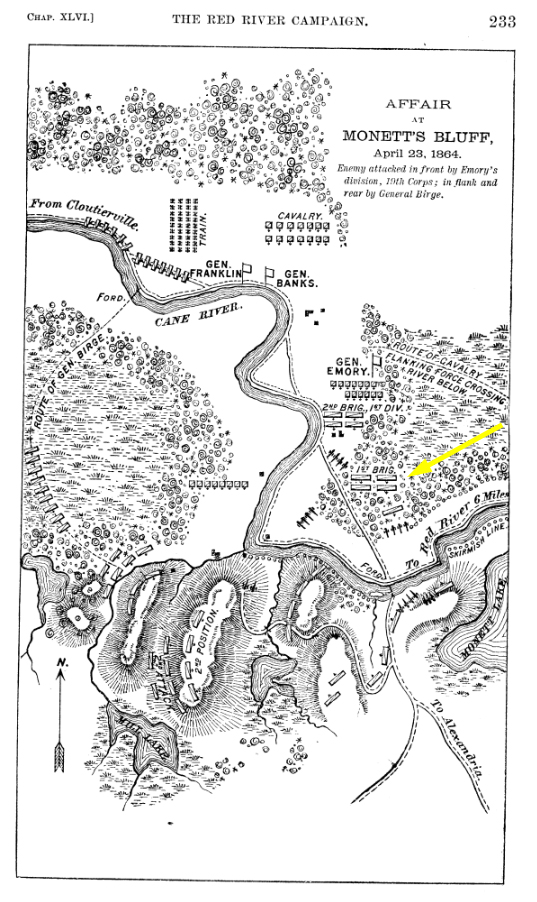
With a few hours of rest, they resumed their march at 4 a.m. on April 23rd. At sunrise, the army arrived at Monett’s Bluff, one of two Cane River crossings along their route of retreat. The Conferates were across the river on a high bank with infantry and artillery . The Third Brigade was ordered to move three miles up the river and cross the stream and go back down the side of the river to attack on the left flank of the Confederates. The 153rd NY volunteers were assigned with the First Brigade and were posted in the trees below the bluff across the river (yellow arrow in map). [55]
While posted in the trees, William Griffis and the 153rd waited for several hours for the Third Brigade to attack while being subjected to constant artillery bombardment from the Confederates on the high bluff across the river. The Third Brigade finally attacked and the battle lasted for an hour. At that point the 153rd’d Brigade was commanded to cross the river and lead a charge on the Confederates. By the time they crossed the river, the Confederates were on the run and fleeing.
Within an hour of the victory, the engineers constructed a pontoon bridge over the Cane River and the army continued its march until midnight. The army rested at Alexandria, Louisiana while constantly skirmishing with Confederates. [56]
The water level of the Red River near Alexandria fell so low that Admiral Porter’s fleet was in peril. There was a mile-long, 758-foot-wide stretch of water that featured two 6-foot-high waterfalls bookending three sets of rapids. The crews of Porter’s flotilla began to offload their heavy cargoes in preparation for running this obstacle course. Unfortunately, within a short time, the water level dropped from nine feet to just more than three feet, virtually grounding the fleet’s 10 heaviest gunboats on the river bottom. Porter, with considerable distance between his vessels and the Mississippi River, was unable to move and faced the possibility of scuttling his entire fleet.
Just as their plans seemed hopeless to salvage the fleet, an officer in the 19th Corps offered Porter a possible solution. Lieutenant Colonel Joseph Bailey, a civil engineer in civilian life, suggested that they build dams to raise the water level. Before the war, Bailey had been a Wisconsin lumberman who had experience in building dams for running log running to sawmills. Bailey had originally proposed the dam option while the army marched northward in early April when he was concerned about the falls at this point in the river. Porter and other engineers originally thought that Bailey’s ideas were “madness”. Given the increasingly dire situation, Porter reluctantly gave his approval.
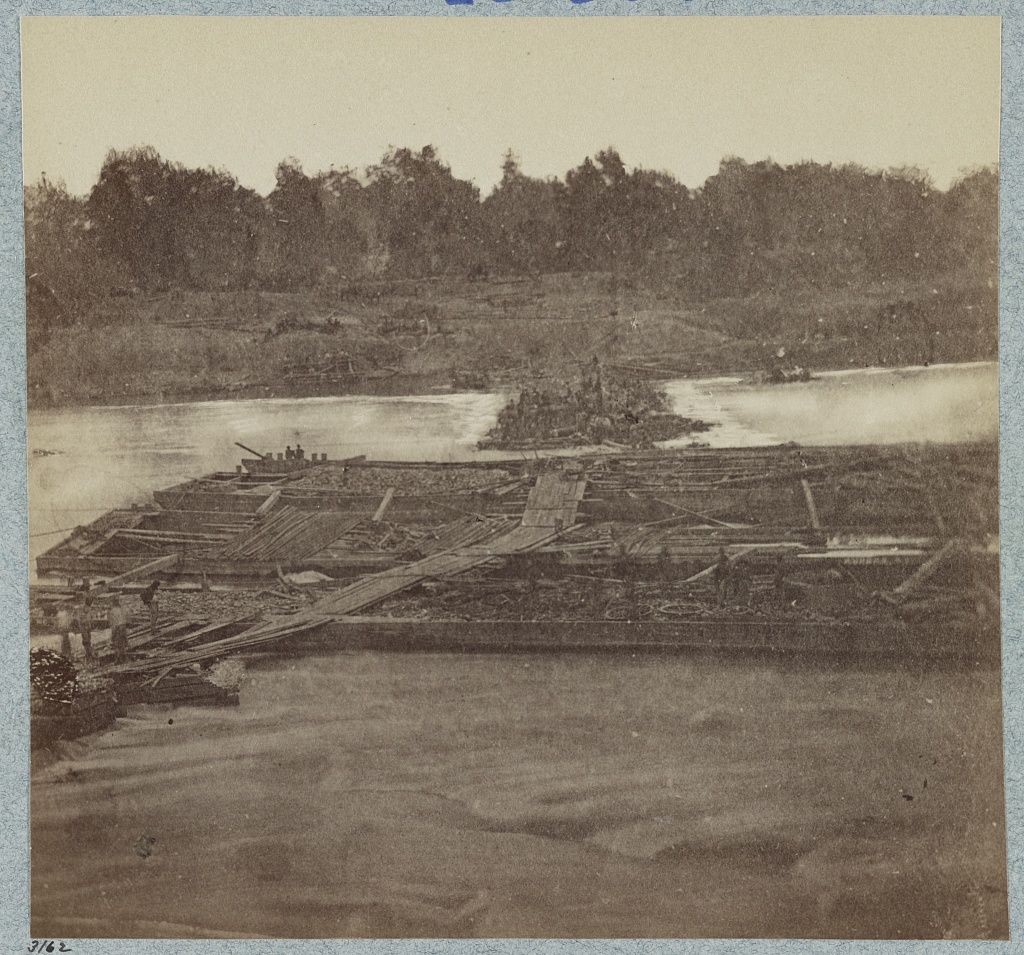
Joseph Bailey built bulwarks to trap water, then let loose the rising flood and saved the Union fleet.
Photograph, Library of Congress [57]
Porter immediately diverted sailors, flatboats, and barges to the project. He also obtained the support of General Banks who reassigned 3,000 troops, as well as scores of mules, oxen, and wagons to assist in the dam building venture.
“Below the falls, Bailey constructed both a crib dam (filled with bricks, stones, and railroad iron) and a tree dam. Bailey then had four 24- by 170-foot coal barges, filled with anything that would sink, submerged at intervals in the middle of the resulting 150-foot-wide gap. This portion of the dam was designed to completely block the water’s flow. Farther upstream, he built two wing dams on both sides of the river to help funnel the water to the main dam area. It was his plan, once the water level rose to a sufficient height, to blast or break through the barriers, thereby allowing the Union vessels to ride the rushing torrent over and past the falls and rapids.“[58]
Bailey ordered the cutting and trimming of oaks, elms, and pines that were plentiful near Pineville, Louisiana. . The operation was fortunate to have ‘skilled labor’ with soldiers from Wisconsin, Maine, and New York who were already familiar with the use of axes and the felling of timber. It is possible that William Griffis was involved with the damn building. Bailey was also had assistance from the 97th and 99th U.S. Colored Troops, two engineer regiments, that were on hand to perform the majority of the main dam’s construction. [59]
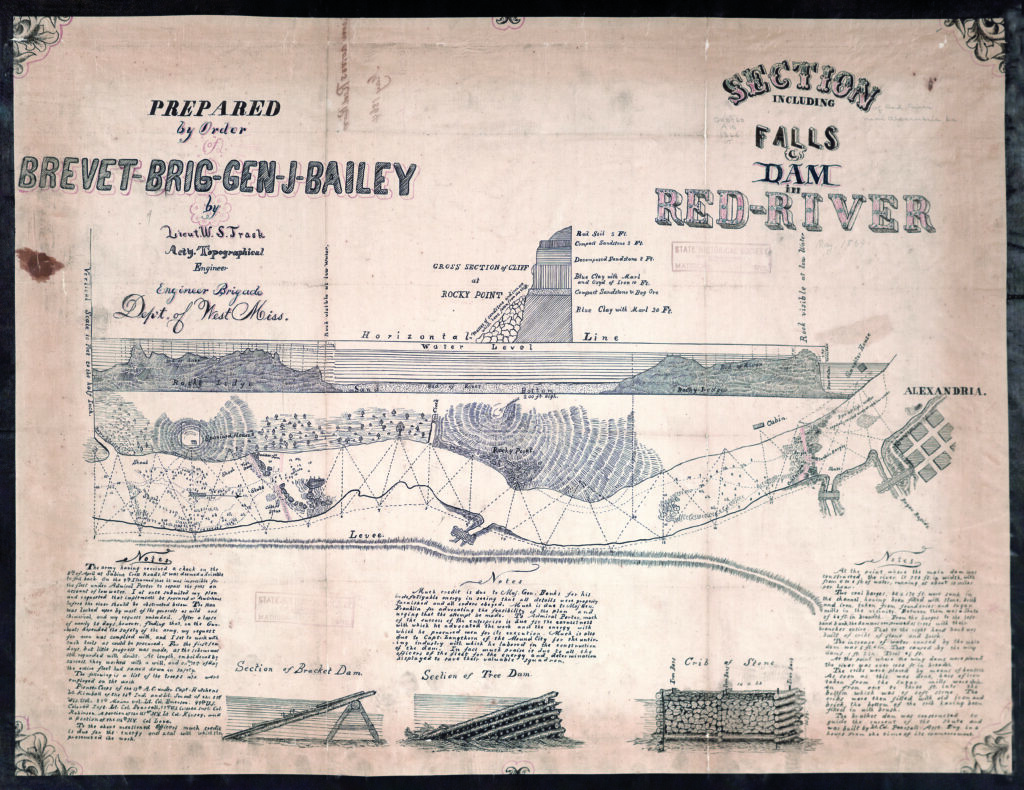
Construction of the dam took 11 days. On May 12th the dam works were completed and Porter’s fleet successfully passed through mile long area near Alexandria.
The army resumed its retreat march skirmishing with Confederate troops the entire way. The 153rd NY Volunteers were part of the the Battle of Mansura (May 15-16) and the Engagement at Avoyelle’s Prairie on May 16th. Confederate Major General Richard Taylor attempted to slow the General Banks’ Union troops’ movements and, if possible, deplete their numbers or destroy them. The Union forces passed Fort DeRussy, reached Marksville, and then continued east.
At Mansura, Taylor massed his forces in an open prairie that controlled access to the three roads traversing the area, where he hoped his artillery could cause many casualties. Early on the morning of May 16th, the Union forces approached, and skirmishing quickly ensued. After a four-hour fight, a large Union force massed for a flank attack, forcing the Confederates to fall back. The Union troops marched to Simmesport. Taylor’s force harassed the enemy’s after the battle with little effect.
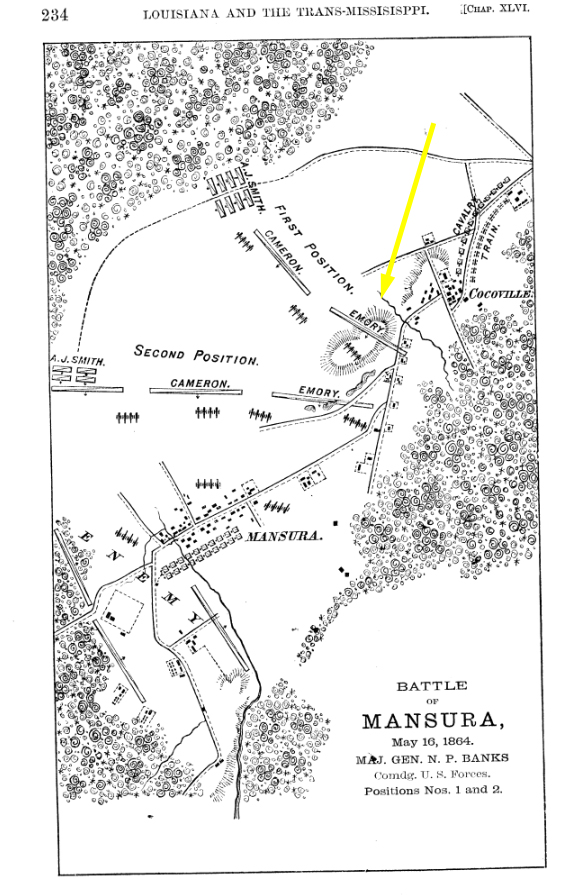
The End of the Red River Campaign
When the 153rd NY regiment reached Morganza on the Mississippi River on May 21st, 1864, the Red River Campaign ended. The 153rd regiment was garrisoned at Morganza between May 21st through July 1st, 1864. At this point, the 16th and 17th Army Corps parted, as agreed upon, from the command of General Banks.
As a soldier from the 114th Regiment, New York State Volunteers stated:
“May 22 – To-day we reached the long desired haven, and have gone to camp on the right bank of he Mississippi, at a landing called Morganza, situated near Morgan’s Bend, and about twenty-five miles above Port Hudson. Gladly were orders for permananert encampment received. Seventy days the hardest kind of campaigning, in excessive heat, and in clouds of dust, much of the time on half rations, often lengthening our march fare into the night, had taxed human endurance to its utmost, and we were happy in the prospect of respite from further toils.”[61]
Another soldier of the 114th distilled his experiences of the Red River campaign as such:
“(We) had marched in the neighborhood of FIVE HUNDRED AND FIFTY MILES. Deducting the time at different places, by halts in advance and in retreat, and in building dams, fortifications and bridges, which is more than half of the whole, there will be left, marching time, barely THIRTY-FOUR DAYS.
“The battle of Sabine Cross Roads, and the march from Pleasant Hill and back, about thirty-five miles, all took place within the sum of TWENTY-FOUR HOURS.
“The March from Natchitoches, and the retreat to Grand Encore, one hundred and six miles, including the battles of Sabine Cross Roads and Pleasant Hill, occupied less than SIX DAYS.
“The distance from Grand Encore to Alexandria, eighty miles, and including the battle of Cane River Crossing, which occupied nearly one-quarter of the time, was made in FOUR DAYS.
“When it is remembered that every soldier carries upon his person a burden of from fort-five to fifty pounds, made up of his fighting equipage – of a part, at least, of his cooking and eating utensils – of the house he lives in – of the clothes he wears – of the bed he sleeps in – and often from three to five day’s rations – and the magnitude of the work performed by the soldiers cannot fail to be comprehended.” [62]
William Returns to the East
In July, 1864, the 1st and 2nd Divisions of the 19th Corps proceeded to New Orleans, and embarked for Virginia, leaving the rest of the regiments of the 19th Corps in Louisiana. This part of the 19th Corps was under the command of General William H. Emory; the 1st Division, containing 17 regiments including the 153rd NY Volunteers, was commanded by General William Dwight; the 2nd Division, containing 4 brigades, 21 regiments, was conmanded by General Cuvier Grover.
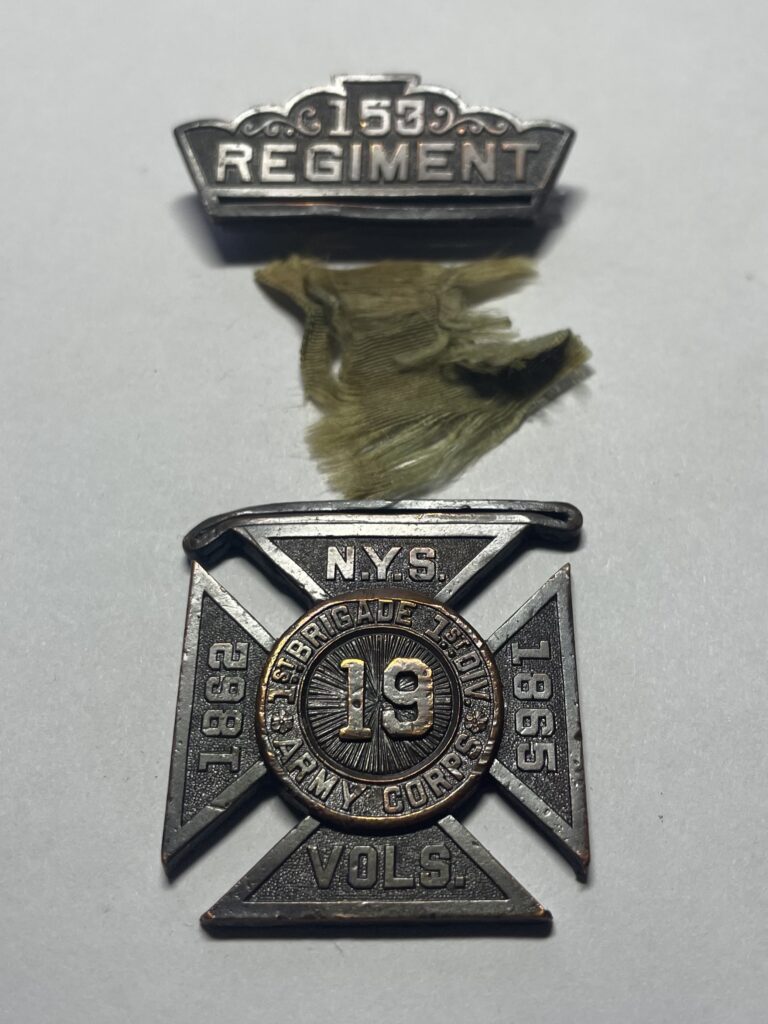
After the Civil War, one of William Griffis’ Grand Army of the Republic (GAR) membership medals, this one was for the 153rd Regiment New York State Volunteers for fighting in the First Division, First Brigade of the the 19th Army Corp. The cross was the Corps insignia.
Click image for enlarged view.
The two divisions embarked for Washington City through Fort Monroe, Hampton, Virginia. On July 1st, the message ‘strike your tents quickly, men’ was passed from company to company. At sundown companies B,E, G, and K of the 114th regiment and the 153rd regiment marched to the steam boat “Crescent”and boarded. By 7 pm the troops started down river, they arrived below Baton Rouge at day break , passed Donaldsonville at noon and came into sight of New Orleans .
At day break on July 3rd the men were ordered off shore at New Orleans and proceeded to the Alabama Cotton Press, a low brick building occupying an entire square with a hollow court in the center. The soldiers were quartered and a ‘strong guard’ was posted to keep them contained. Yet during the day a considerable number secured passes or obtained access to the town. Although it was Sunday, they found shops and stores open.
Public squares were filled with sportive children. The great French market swarmed with a noise, chattering, gesticulating multitude of French-men, Spaniards, Creoles, Germans, Irish, Africans and Multattoes. A perfect Babel of languages, yet all were in wonderful good humor, as they sipped their tiny cups of coffeee, or partook of some dainty French dish. [63]
They proceeded to reboard the Corinthian and set sail on July 5th and Colonel Davis of the 153rd opened his sealed orders to discover their destination. They were to proceed to Fort Monroe, Old Point Comfort, Virginia to receive further orders from Brigadier General Emory, commanding the detachment of the 19th Army Corp. They were to avoid Key West on the account of the prevalence of yellow fever.
The first day of their voyage on July 4th was one of great heat and the sea “as smooth as a pond”. The men sweltered in the iron walls of the vessel. The next two days were a continuation of calm, hot weather. They passed within a few miles of the Dry Tortugas and had “an excellent view of Fort Jefferson” and mid day were in sight of Key West. Several days passed and on the afternoon of July 9th, they passed Hatteras Inlet and in the evening the night house on the Cape wash far astern.
The forenoon of the 10th, the Crescent came in sight of Cape Henry, and soon took aboard a pilot. As they sailed forward, the heavy stone walls of Fortress Monroe, the little rocky island of the Rip Raps, the shores, forests and houses every moment came more distinctly in view. [64]
At noon, Colonel Davis went shore and quickly returned with orders to proceed to Washington City. General Grant ordered the 19th Army Corps to Washington City to defend the city against a possible attack by Confederate forces under the command of Lieutenant General Jubal Early.
It was quite certain that the Nineteenth Corps was ordered North for the purpose of re-enforcing the Army of he Potomac at Petersburg, but the first transport arriving at Fort Monroe at the exact time that the news of the rebel raid into Maryland was received, they were hurried forward to the defense of the Capital, and if necessary, of more northern towns and cities. [65]
The 153rd arrived at Washington City on July 11 a little after noon and marched north to Fort Stevens. The city of Washington prepared for the Confederate assault in the midst of one of the worst hot spells in its history that lasted 47 days without rain with temperatures exceeding 90 °F. [66] Despite the number of troops in the capital, the city Washington was really lacking in its defensive capabilities. General John G. Barnard, Grant’s engineering officer, noted that many of the troops were not actually fit for duty because they were new recruits, unseasoned reserves, troops recovering from wounds, or worn-out veterans. Bernard estimated that instead of 31,000, the actual number of effective troops was around 9,600, equal to Early’s number of troops. [67]. The arrival of the 6th and 19th Army Corps brought desperately needed veteran reinforcements.
President Lincoln, his wife Mary, and some officers rode out to observe the attack, either on July 11 or July 12, and were briefly under enemy fire that wounded a Union surgeon standing next to Lincoln on the Fort Stevens parapet. [68] The additional Union reinforcements from the 6th and 19th Army Corps arrived and were placed in reserve behind the line. The skirmishing continued into July 12th, when Early finally decided that Washington could not be taken without heavy losses. [69]
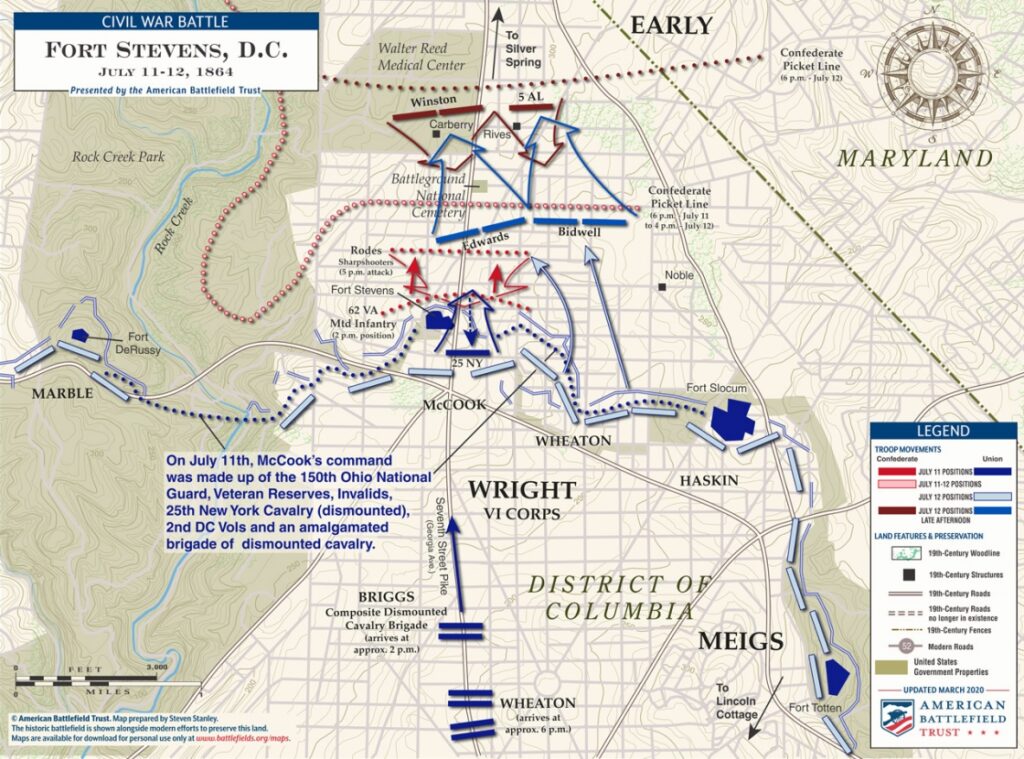
The following is an entertaining rendition of what happened during the battle of Fort Stevens with the 6th and 19th Corps marching through Washington to assist in the defense of Fort Stevens. [70]
Between July 14th and the 23rd, 1864, the 153rd regiment, as part of the 19th Army Corps, marched westward in pursuit of Early’s troops, following the Confederate forces through Snicker’s Gap and in the the Shenandoah Valley.
On the 15th, the 19th Army Corp passed through Rushville, Maryland and forded Seneca Creek and encamped without supper. In the morning a new commissary arrived for the First Brigade with a wagon train of supplies. providing food for the troops. [71]
On the 16th the troops marched through Poolesville and halted, waiting for the passage of the 6th Corps over the Potomac River. They forded the Potomac between 5 and 6 in the early evening.
“An unusual sight here met the eyes of men. From bank to bank, stretching across the water for 600 feet, a column of soldiers were floundering, splashing and struggling against the current, while they were slowly moving over to he opposite side. Quickly the boys made preparations for crossing the stream. Removing their cartridge boxes and haversacks, they attached them to the end of their guns. Some divested themselves of their shoes and stocking, and others rolled up their trousers to their hips. Then plunging into the cold water, they slowly felt their way over the slippery rocks. In the middle of the river the water was about waist deep, and there very many unlucky men who were carried off their feet, receiving a thorough ducking before they could recover themselves.” [72]
They entered Virginia and resumed their march on July 17th. They passed through Leesburgh, Virgina early morning on July 18th and continued through Hamilton, Purcellville towards Snicker’s Gap. By sundown they entered the Gap and bivouacked at 9 in the evening.
Early on July 20th a reconnaissance force found that the Confederates had fallen back and the army was ordered to advance. Later in the day it was found that the Confederates retreated further into the valley and the pursuit was discontinued. A terrible shower drenched the men and muddied the road. They reforded the Shenandoah, toiled up the mountainside, through the Gap and descended in Louden County. The morning sun dawned on the men as they reached Leesburg. Many of the men were indignant at the treatment they received for having to be rushed along and then ordered to fall back to Washington. [73]
In the evening of July 21st, the regiment broke camp and crossed over Goose Creek and camped on the opposite side. On the 22nd they marched through Drainsville. At 8 in the evening the troops sought out places to sleep upon a rough and stony field. The troops were again in line at 7 a.m. on the 23rd and pushed toward Washington. In the afternoon they went through Lewsiville near a steep and deep gorge to the Potomac and crosssed a chain bridge coming out on the Maryland side and camped a mile down the road at Battery Vermont.
In the ten days of being in the Army of the Potomac, the 19 army corps had marched 125 miles [74]
“On the evening of the 25th of July, the exciting intelligence was received that the enemy was again in Maryland. Orders were given given to be ready to march in the morning, with four day’s rations in haversacks, and eight day’s in the wagons. All night the Quartermasters and Commissaries labored to supply the men with food and clothing. The sick, of which there were quite a number in camp, were sent to the hospitals in the city.” [75]
On the 26th at 10 a.m. the army was on the march, going through Tennallytown, then through Rockville and bivouacked five miles beyond at midnight.
The following day the army marched through the little villages of Seneca Mills, Middlebrook, and Clarksburgh. In the afternoon they marched through Hyattsville and bivouacked a few miles beyond.
On July 27th at 5 a.m. resumed the march and were ordered to stop at the Monocacy River. They found the debris of battle, bloody clothing, shoes and caps scattered in the fields from the prior battle between Early’s army and the Union General Lew Wallace. The 19th marched two miles up the river and then waded through the stream and continued marching to Frederick.
“The citizens were all in the streets, witnessing the approach of the army. From windows and from house tops, flags were flying. Well dressed and handsome ladies were flirting handkerchiefs, or throwing bouquets in the ranks. By the sidewalks, pails fo water and lemonade, or baskets of cake and fruit, were placed for the soldiers to help themselves as they passed along. Little children ran through the lines to distribute knickknacks. Women overloaded the haversacks and pockets of men with all manner of goodies.” [76]
After passing through the city the 19th they stopped to allow the 6th corps to move ahead. Advancing four miles on the 19th, they bivouacked in a wheat field. At this point, General Hunter in command of the Department of Western Virginia took command of the 19th Corp.
On July 29th the column was in motion on the road to Harper’s Ferry. They marched through Peterson, Knoxville, Weaverton, and entered Harper’s Ferry near sunset. They passed through the village of Bolivar and camped after 20 miles of marching.
On the 31st the 6th and 19th continued their march to Frederick and two and a half miles on the Emmetsburgh Pike and camped in a wooded area.
On the 30th of July information was received that the Confederates were moving towards Pennsylvania and destroyed Chambersburg. Instantly the army was put in motion retracing their steps through Bolivar and Harper’s Ferry and camped past Petersville near Kittoctan Creek. The following day at 6 a.m. the 6th and 19th continued toward Frederick. “The day was extremely hot and sultry.” Over 200 men in the 6th Army Corp fell down in the road from sunstroke.
My Brother was Close By
August 1st, the troops rested having heard that the rebels recrossed the Potomac. At this time the entire 19th Corps was augmented with General Grover’s Division and General Dwight was in charge of the First Division. General Emory was in command of the entire 19th.
For two days the Army was at Monocacy Junction, Maryland. Finally at 4 p.m. on August 4 the order came to move with 4 days of rations. Troops were constantly moving by rail towards Harper’s Ferry. The 19th Corps was waiting by the Baltimore and Ohio (B&O) Railway. At 1 in the morning an order came for the First Brigade of the 19th Corps to jump aboard a train.
“The box cars were very crowded, even their roofs contained scarcely a hanging-on place, being covered with officers and men. Soon the whistle blew and the ponderous train moved off through the darkness.” [77] By morning the men unloaded at Maryland Lights.
“The men were being disgusted with marching hither and thither, in pursuit of the enemy, but never able to find him. It seems to them useless labor to pass between Monocacy and Harper’s Ferry, three times in a single week.” [78]
As indicated earlier in this story, the First NY Dragoons remained at camp from July 2nd to the 26th. On August 1, 1863, the First Dragoons took a transport, moving out of City Point, Virginia for Washington City and arrived on August 6th. They marched through Washington on August 6 and continued through Georgetown, Rockville, Clarksburg, Monocacy Bridge, Sandy Hook, and finally to Harper’s Ferry. Daniel’s regiment mirrored part of the route of his brother William’s regimental route to Harper’s ferry.

It is not known if the two brothers were aware of their proximity at this point in time. While Daniel and William were bivouacked in Harper’s Ferry August 9-11, Sheridan’s Army of the Shenandoah consisted of roughly 50,000 troops. It is unlikely they knew they were so close to each other. Even if they were cognizant of their proximity, the ability to see each other was likely out of the question. Daniel and William were geographically so close to each other but in many ways miles apart physically, psychologically and emotionally. Now they were to share a short period of time as soldiers under General Sheridan on the march south into the Shenandoah valley. Between August 5th through the 13th, Daniel and William were physically closer to each other than they could have imagined throughout the Civil War and it would have family altering effects.
On August 7th Sheridan arrived and took command of the army. For the two divisions of the 19th Army Corp that were ordered to come north to fight under Sheridan, the two divisions in August, 1864, had an aggregate strength of 21,640, present and absent; 14,645 present, with 13,176 present for duty. [80]
On August 10 at 5 in the morning , Sheridan started his entire army from its secure camp on Bolivar Heights for the Shenandoah Valley Campaign. At 9 in the morning they reached Charlestown. Beyond the town the 8th Corps was sent to the left of the pike, the 6th to the right and the 19th in the center of the road. All moved in parallel columns. The wagon train, pursuant to Army Orders and practice were probably behind the 6th, 8th and 19th army Corps guarded by 100 day men. [81] After an 18 mile march they camped near Berryville at 5 pm.
On the 11th William and his comrades marched left of the road in open country guided by compass and camped near Newtown. The marched by the flank, slowly feeling their way southward. They could hear cannon towards the front, signifying that the calvary was engaged with the Confederates.
“That day our men tramped over rough, rocky fields, through deep, tangled forests, fording clear running streams, pushing over stone walls, or tearing down rail fences, to make a passage for the column. At sundown they camped near the village of Newtown.” [82]
On the 12th the troops marched to the valley pike. “This celebrated thoroughfare is, perhaps the best specimen of a macadamized road in the country. Notwithstanding immense armies, with their ponderous wagon trains and artillery, had continually passed to and fro for three years over this road, with a single reapair upon it, our men found it as smooth and as hard as the best pavement. Not a rut or a mud – hole marred its wide , even surface . The mules trundled the army wagons over it with comparative ease , while their hoofs gave out a metallic ring.” [83]
The army moved alongside the pike in parallel columns through the adjoining fields while the advance portions of the army kept up a continual fire on the rebel rear guard. In the afternoon of August 12th the army passed through the village of Middletown, Virginia and camped in an open, level field.
Before daylight on August 13th, the troops were ordered to “stand under arms until sunrise”. Throughout the day the 19th Army Corp, William’s regiment, remained quiet in camp while the 6th Corps was skirmishing with the Confederates.
As Harris Beecher of the 114th NY Volunteers, who was part of the same Brigade and Army Corps as William Griffis’ 153rd regiment, recalled:
“The rations of our men were now exhausted, and the supply train was captured and destroyed the evening before, by Mosby’s guerrillas, who, having passed through Snicker’s Gap, were hovering in the rear.” [84]
This is when Daniel Griffis was captured and made prisoner. William was ‘standing under arms’ close to Newtown, Virgina. Daniel was captured near Berryville, Virginia, 31 miles away. The story of Daniel Griffis’ capture and subsequent imprisonment is told in another story.
In a subsequent report to General Robert E. Lee, Lieutenant Colonel Robert Mosby summarized his August 13, 1864 raid:
“On the morning of August 13 I attacked, near Berryville, the enemy’s supply train, which was guarded by some 700- or 800 infantry and calvary, under the command of Brigadier-General Kenly. Completely routed the guard, with a loss over 200 prisoners, including 3 lieutenants, besides several killed and wounded. Captured and destroyed 75 loaded wagons and secured over 200 head of beef-cattle, between 500 and 600 horses and mules, and many valuable stores. My loss 2 killed and 3 wounded. My force numbered something over 300 men, with two mountain howitzers. One howitzer became disabled before being brought into action by breaking a wheel; the other after firing a few rounds was rendered useless also by breaking of the carriage.” [85]
General Lee subsequently relayed this information to the Confederate Secretary of War:
“Colonel Mosby reports that he attacked the enemies supply train near Berryville on the 13th; captured and destroyed 75 loaded wagons and secured over 200 prisoners, including several officers, between 500 and 600 horses and mules, upward of 200 beef-cattle and many valuable stores. Considerable number the enemy killed and wounded. His loss 2 killed and 3 wounded.” [86]
The Army of the Shenandoah
The army corps that came together in a time of emergency were now permanently organized in a distinct Army of the Shenandoah, it included the 6th, 8th and 19th Corps of infantry and a Calvary Corps under general Torbert, which included the First NY Dragoons.
In the afternoon of the 13th, a wagon train arrived loaded with provisions to replenish the supplies needed for William Griffis and the 19th Corps. Mosby’s actions compelled Sherman to fall back. Their movement commenced at 11 in the evening on the 15th. The 19th Corps took the lead with the 6th taking the rear. By the light of the moon, men chatted, they passed Middletown, Newtown and Kearnstown. Daylight found them on the outskirts of Winchester.
The camped outside of Winchester but at 4 a.m. on the 17th they were ordered to move. They traveled east on the Berryville Pike and forded two creeks and were back on the Pike, reaching Berryville at noon. The regiment went into camp on he same spot they had occupied when making their advance. It was this place that the supply wagon trains had been captured by Mosby.
For fear of losing a portion of their wagon train to Mosby, on the 18th the army was ordered to retire in the direction fo Charleston, thirteen miles away. Toward the evening they bivouacked about three miles from Charleston near the Pike. They remained there until the 21st. , hearing constant firing in the direction of Berryville. About noon they started toward Charleston and reach the town in an hour, William’s regiment posted a battle line along the road. Nothing happened and the troops once again commenced their retreat. They reached their old camp in Bolivar Heights, Harper’s Ferry at 3 a.m. on August 22.
“It was clear that the General was pursuing a Fabian policy, in pursuance of orders from the Cammander-in Chief. He avoided an open contest, yet he was constantly near the enemy, and sought in every way to annoy him. He endeavored to prevent him from joining his main army at Petersburg, while on the other hand, the rebels are evidently practicing similar tactics.” [87]
On one of their recurrent marches from their Harper’s Ferry base camp, on September 2nd, they heard of Sherman’s capture of Atlanta. On September 17th, news flew through their camp that General Grant had arrived at their Headquarters.
“The remarks became general around campfires: “Now we shall have lively times.” “Old Grant will stop this playing with the enemy.” “Lookout now for a big fight.” Some of us fellows won’t be living in a few days.” [88]
General Grant had given orders to General Sheridan to go into the Shenandoah Valley with the intent of destroying General Early’s Army and the burn the countryside to halt further use of their resources against the Union army. Sheridan initially started slowly, primarily because the impending presidential election of 1864 demanded a cautious approach, avoiding any disaster that might lead to the defeat of Abraham Lincoln. Now General Grant had given Sheridan the green light to proceed.

William’s regiment, the 153rd, was engaged in the Third Battle of Winchester, Virginia on September 19th, the Battle of Fisher’s Hill on September 22nd; and the Battle of Cedar Creek on October 19th. The last battle marked the destruction of Early’s forces and removed future hinderances forUnion troops in the Shenandoah valley.
Confederate General Early mistook Sheridan’s limited action in August to mean that Sheridan was afraid to fight, and he left his army spread out from Martinsburg to Winchester. Sheridan learned of Early’s dispersed forces and immediately struck out after Winchester, the location of two previous major engagements during the war, both of which were Confederate victories.
The Opequon: The Third Battle of Winchester [89]
Daniel’s Regiment of the First NY Dragoons and William’s regiment, the 153rd NY Volunteers fought at the battle of Opequon. [90] The Union forces coming in from the east had to march on the narrow road through Berryville Canyon, which got congested with supply wagons and troops, delaying the attack. This delay allowed Early to further strengthen his lines. [91]

At 11:40 A.M., Sheridan attacked with Major General Wright’s Union 6th Corps on the left flank on the Berryville Turnpike and the 19th Corps of which the 153rd regiment was a part, under Major General Emory, occupying the ground from Wright’s right flank northward to Red Bud Run. (Yellow arrow in the map above and below indicates the movement of the 153rd NY Volunteers). The Sixth Corps was supported by well placed batteries but Emory had no artillery going into the battle due to the rugged and wooded nature of the terrain.
“Soon our men began to tramp in the shade of huge trees, where nothing was heard save the rustling of multitudinous feet, and the crackling of little trigs upon dry leaves. It seems as though everyone was holding his breath, in the dread stillness that preceded the impending crash. … and immediately the solemn woods roared and echoed with the crash of a thousand muskets. Then yells and shrieks, the hissing noise of misses, the heavy, deep base of artillery, the humming of fragments of shells, joined in the confusion of unearthly sounds.” [92]
After encountering heavy resistance from the Confederate divisions of Major General Stephen D. Ramseur on the Berryville Pike and John B. Gordon’s division (located in the Second Woods and Middle Field) in front of the XIX Corps, Sheridan succeeded in driving back the Confederates from their initial positions.
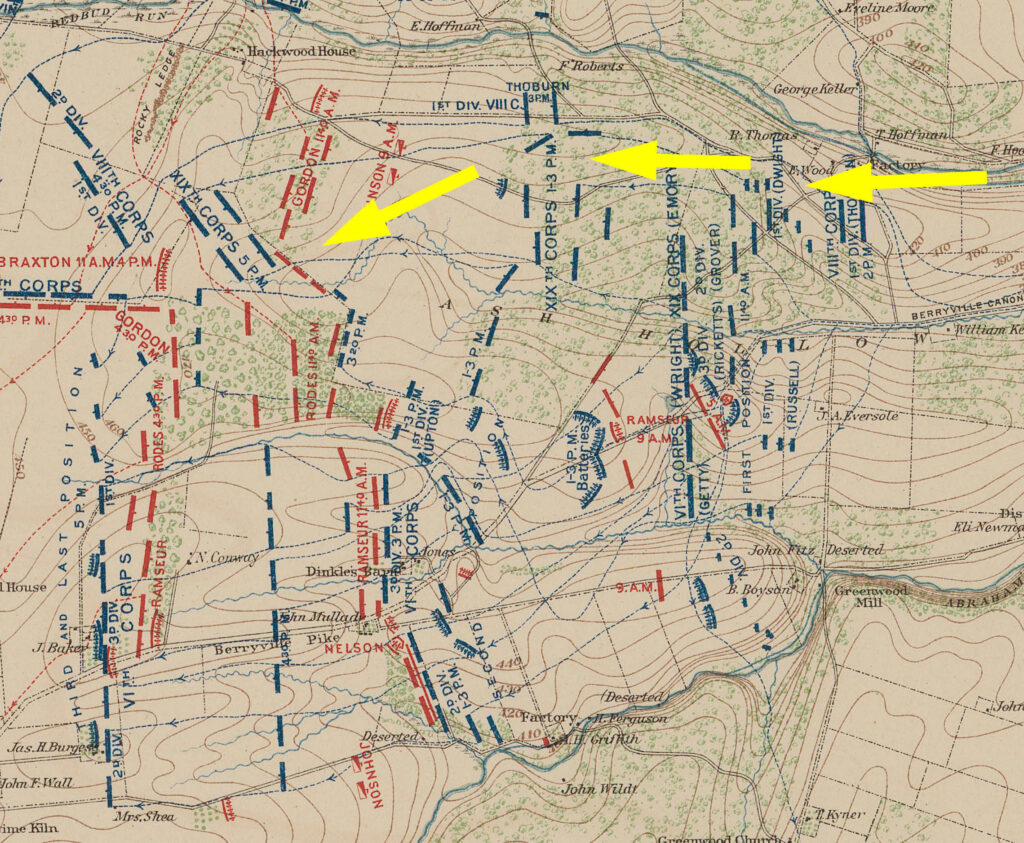
Although Sheridan’s initial attack was successful, the terrain and road network combined with fierce Confederate artillery created a large gap in the center of the Union battle line. Lucky for General Early, the confederate Division of Major General Rodes arrived on the battle field and counterattacked in this gap, forcing both the 6th and 19th Corps to retreat. Sheridan, however, closed the breach by advancing the reserve divisions of the 6th and 19th Corps (William’s Corps). The 6th Corps division of Brigadier General Russell, who lost his life restoring the broken battle line, restored the broken line in the vicinity of the Berryville Pike to Ash Hollow in the center. In the northern sector of the battlefield, Brigadier General Dwight’s division held the Union right flank after much bitter fighting against Gordon and elements of Rodes’s command. Approximately at 2:00 p.m, a lull developed over the Berryville Pike sector of the battlefield, although Gordon kept up the pressure against Emory’s 19th Corps in the Middle Field near Red Bud Run.
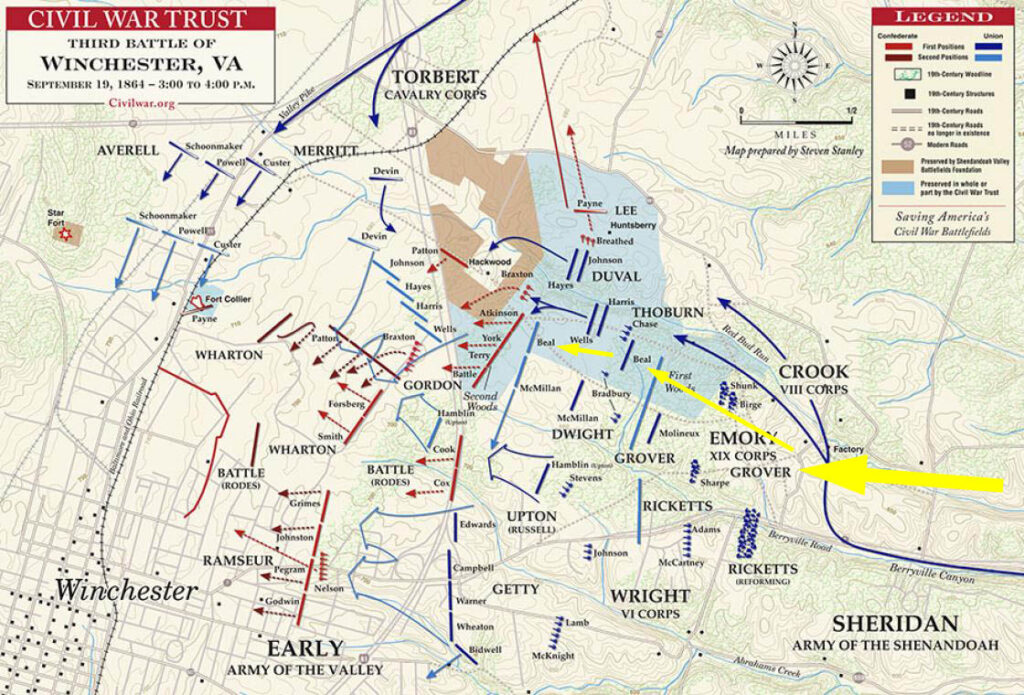
When the outcome of the initial noontime attack seemed in doubt, Sheridan sent the Army of West Virginia under Brigadier General George Crook (8th Army Corps) to locate the Confederate left flank and protect the right flank of the 19th Corps. Sheridan also ordered Brigadier General James H. Wilson’s cavalry division to advance toward Early’s right flank and cut off his line of retreat from Winchester. Wilson was late to start and was unsuccessful in his mission. Sheridan rode to his right flank where he found the hard pressed 19th Corps and assured General Emory that Crook was coming up and that the Union forces would ‘whip the rebels’. Crook reached the Union right flank, he found Sheridan waiting for him and advanced into the First Woods toward the Middle Field where Dwight’s division was still hanging on after taking heavy losses in its fight with Gordon. Crook decided to relieve the 19th Corps with Col. Joseph Thoburn’s division and then personally led Colonel Isaac Duval’s division on a flank march north of Red Bud Run and attack Gordon’s left flank.
When Crook attacked, Sheridan ordered the 6th Corps to join the attack. Ramseurs’ and Rodes Confederate divisions and Colonel Carter’s southern artillery offered resistance to the 6th Corps attack. Sheridan rode along its battle line, rallying and inspiring the troops as he moved toward the Berryville Pike.
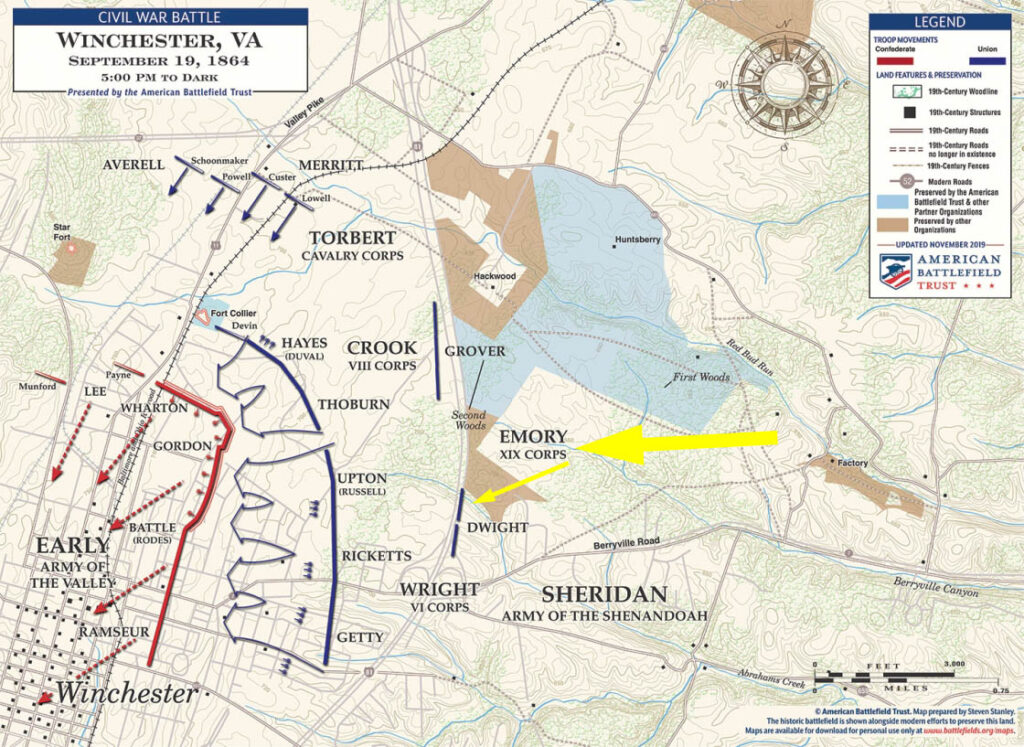
By 5:00 p.m., the Confederate line was completely surrounded with only an exit through Winchester. Early’s Confederate troops began to fall back through Winchester. Torbert’s Union cavalry charge down the Valley Turnpike captured the Star Fort, Fort Collier and many of their Confederate defenders, ending the battle. During the battle, fourteen Union enlisted men and one officer received the Medal of Honor for their actions. Two of the fourteen were members of the First NY Dragoons.
Battle of Fisher’s Hill
Shortly after the third battle of Winchester, Sheridan’s Army followed Early’s troops into the valley. Early knew the Valley well and understood that Fisher’s Hill afforded the best immediate opportunity to defend against Sheridan. The previous month he had sought refuge at Fisher’s Hill after feeling threatened by Federal forces and was never attacked. The battered Confederate army arrived at Fisher’s Hill during the early morning hours of September 20th and by noon had taken up defensive positions facing north to Strasburg. In order to adequately defend Fisher’s Hill, Early needed to have enough troops to stretch out over a four-mile front from Little North Mountain to Massanutten or his flanks would be exposed and vulnerable to assault. Despite the strength of being situated on a ridge, Early did not have a sufficient of troops to cover the four mile line. He was spread thin. [93]
Sheridan and his generals realized a frontal attack was unlikely to succeed and would result in heavy casualties. Major General George Crook came up with a plan that would involve his men getting into position during the night to flank the weak left side of enemy, the 6th and 19th corps could distract the Confederates by moving against Early’s front.

“Throughout the day on the 21st, Crook’s men stayed concealed in the woods north of Cedar Creek while the VI and XIX corps marched from the area around Strasburg south to Fisher’s Hill. Troops of the VI Corps occupied a small hill in front of Fisher’s Hill that was a good platform for artillery. Meanwhile, Crook’s men waited for the cover of darkness. Then, as the sun began to set, they marched southwest and occupied a position in an area of dense woods slightly north of Hupp’s Hill. Crook wore a private’s blouse, just in case prying eyes from Massanutten happened to land on him, and he ordered his color bearers to trail their flags, fearing that the bright colors of the Stars and Stripes or flagpole finials would attract attention.” [95]
To distract Early’s troops from the 8th Corps on their left flank, Sheridan directed Emory (19th Corps – William Griffis’ location) and Wright (6th Corps) to increase their activity along the Rebel front. The VIII Corps then moved into position along the eastern face of Little North Mountain and attacked at 4 p.m. The Confederate defense collapsed from west to east based on Crook’s efforts as Sheridan’s other corps joined in the assault along the Valley Pike.
Battle of Cedar Creek
The last major battle the William Griffis and the 153rd NY Volunteers fought was the Battle of Cedar Creek. [96] At dawn, October 19, 1864, the Confederate Army of the Valley under Lieutenant General Jubal A. Early surprised the Federal army at Cedar Creek and routed the 8th, 19th and 6th Corps. Sheridan arrived 16 miles from Winchester to rally his troops, and, in the afternoon, launched a crushing counterattack, which recovered the battlefield. Sheridan’s victory at Cedar Creek broke the back of the Confederate army in the Shenandoah Valley.
The following video provides from American Battlefield Trust provides an excellent animated view of a battle that turned the tide against early and the Confederate forces in the Shenandoah valley.
Between November 28, 1864 and April 5, 1865, the 153rd NY Volunteers were assigned duty at Middletown, Newton and Stephenson’s Depot in Virginia until being transferred to Washington City on April 5, 1864. The regiment resumed duty in Washington City April 5, after a year and a half away from their original provost guard duties.
The Grand Review June 1865
After Lee’s surrender the regiment assisted in the grand review of the armies of Meade and Sherman on May 23, 1865, celebrating the end of the Civil War. This parade took two days with the eastern and western armies parading down Pennsylvania Avenue. [97]
On the first day, Edwards and the men of the 29th Regiment of Maine along with the Army of the Potomac and the Army of the Shenandoah marched past the reviewing stand where Johnson, General Ulysses S. Grant, and other dignitaries watched. General Meade, who was victorious at Gettysburg, led the eighty thousand soldiers of the Army of the Potomac with which by various accounts was an impressive sight. He then dismounted his horse at the reviewing stand in front of the White House to join the other dignitaries so that he too could salute his men who passed by over the next six hours. William Griffis was probably part of this march.
On the second day, General William T. Sherman led both the Army of Georgia, which had just completed a two thousand mile march through the heart of the Confederacy, and the Army of Tennessee that had arrived at Washington by train. Though tattered and worn, Sherman and the approximately sixty-five thousand troops marched down Pennsylvania Avenue.
The End of War in Savannah, Georgia
In July 1865, William Griffis and the 153rd was transferred to the Department of Georgia and was stationed at Savannah, Georgia. On October 2, 1865, the regiment was mustered out of service. During its service the regiment lost one officer and 38 enlisted men, killed or mortally wounded in battle. The regiment also lost one officer and 160 enlisted men due to disease. Total casualties were 200 or about 20 percent of the regiment’s original strength.
William Griffis went back home to Mayfield, New York area. He married Ruth Amanda Carpenter (1845-1914). Through their marriage they lived in Johnstown and Gloversville, New York. Throughout the remainder of his life, William Griffis experienced periodic bouts of fatigue and illness from his war experiences of sun stroke and ‘lung disease’.
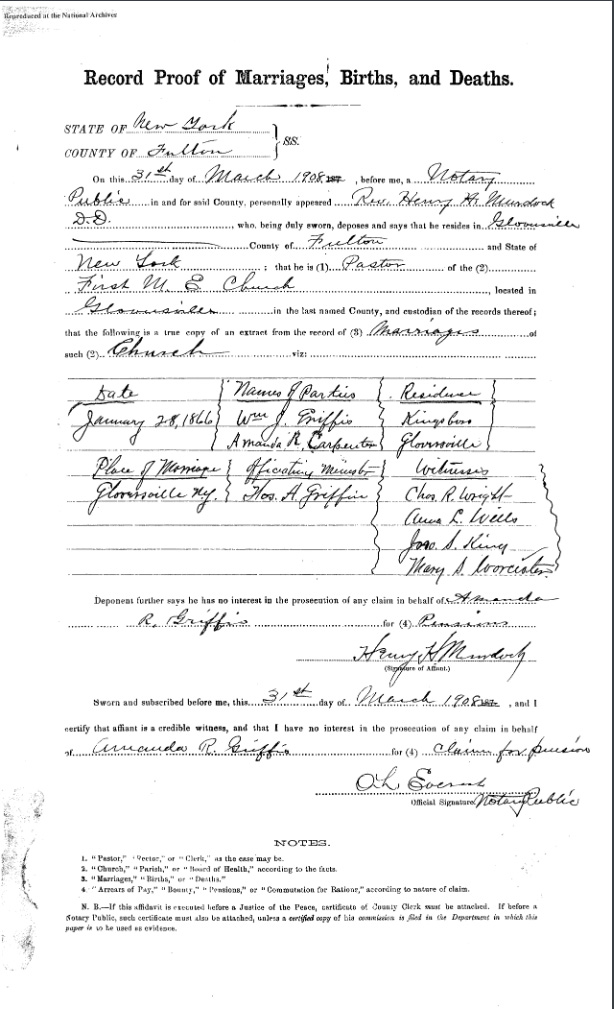
This is a record of proof of marriage that is from Amanda Griffis’ request for a widower’s pension after William passed. [98]

William and Amanda had four children.
It is not known when William found out that his brother Daniel was captured and died in a prisoner hospital.
Sources
Featured photograph: Photograph by Andrew J. Russell, U.S. Military photographer, Town of Culpepper Courthouse Under Union Occupation in the Fall of 1863, after major General George Meade’s army crossed the Rappahannock River. Clark B Hall Collection; Hall, Clark B., Rare images reveal a town torn by war, Mar 23, 2019. This was a town that Daniel Griffis probably passed through as a wagon master during the Campaigns with General Sheridan.
[1] John W. DeForest, “The Confederates Escape in the Teche Country”, in Henry Steel Commander, The Blue & the Gray, Vol I, Indianapolis: Bobbs-Merrill Company, 1950, Page 474
[2] Brooksher, William Riley. War Along the Bayous: The 1864 Red River Campaign in Louisiana. Washington, D.C.: Brassey’s, 1998; Frassanito, William A. Grant and Lee: The Virginia Campaigns 1864–1865. New York: Scribner, 1983; Gallagher, Gary W., ed. The Wilderness Campaign. Chapel Hill: University of North Carolina Press, 1997; Josephy, Jr., Alvin M. The Civil War in the American West. New York: Alfred A. Knopf, 1992.; Kennedy, Frances H. The Civil War Battlefield Guide. New York: Houghton Miflin, 1998; Robertson, Henry, The Red River Campaign and Its Toll: 69 Bloody Days in Louisiana, March-May 1864. Jefferson, NC: McFarland, 2016; Symonds, Craig L. A Battlefield Atlas of the Civil War. Annapolis, Maryland: The Nautical and Aviation Publishing Company of America, 1983.; Troop engagements of the American Civil War, 1864, Wikipedia, page was last edited on 24 August 2020, page accessed 15 Jan 2021.; Nathaniel P. Banks, Wikipedia, page was last edited on 28 January 2021, page accessed 9 Feb 2021; Overland Campaign, Wikipedia, page was last edited on 9 February 2021; The Red River Campaign, American Battlefield Trust, page accessed 29 Jan 2021
[3] James Riley Bowen, Regimental History of the First New York Dragoons, Page 134.
[4] Shenandoah Valley Campaigns 21 Aug 2018, History.com; The Campaigns, Shenandoah Battlefields
[5] Gordon C. Rhea is an American lawyer and historian, who specializes in the American Civil War especially the Overland Campaign, his academic works are:
- The Battle of the Wilderness, May 5–6, 1864. Baton Rouge: Louisiana State University Press, 1994.
- The Battles for Spotsylvania Court House and the Road to Yellow Tavern, May 7–12, 1864. Baton Rouge: Louisiana State University Press, 1997.
- Cold Harbor: Grant and Lee, May 26–June 3, 1864. Baton Rouge: Louisiana State University Press, 2002.
[6] Battle of the Wilderness, Wikipedia, page was last edited on 21 January 2021, page access 30 Jan 2021; Spotsylvania Court House, Wikipedia, page updated 8 Feb 2021, page accessed 10 Feb 2021
[7] Wittenberg, Eric J. Little Phil: A Reassessment of the Civil War Leadership of Gen. Philip H. Sheridan. Washington, DC: Potomac Books, 2002, Page 24-27
Philip Sheridan, Wikipedia, page updated 2 Feb 2021, page accessed 10 Feb 2021
[8] James Riley Bowen, Regimental History of the First New York Dragoons, Page 145
[9] Ibid, Page 153
[10] Battle of Yellow Tavern, Wikipedia, page updated 31 Jan 2021, page accessed 3 Feb 2021; Battle of Meadow Bridge, Wikipedia, page updated 20 Mar 2020, page accessed 20 Jan 2021
[11] James Riley Bowen, Regimental History of the First New York Dragoons, Page 156
[12] Ibid, Page 161
[13] Ibid, Page 167
[14] Kentucky Equine Research Staff, Synchronous Diaphragmatic Flutter , Equinews Nutrition and Health Daily, Kentucky Equine research, 1 Dec 2005; Muscle Cramping in Horses, Merck Manual Veterinary Manual; Equine ‘Thumps’ Are More than Mere Hiccups, University of Illinois College of Agriculture, The Horse 5 Aug 2008; T Douglas Byars, Bruce C McGorum, Disorders of the Thoracic Wall, Pleura, Mediastinum, and Diaphragm, in Equine Respiratory Medicine and Surgery, Elsevier 2007 ; Martha M. Misheff, Lameness in Endurance Horses, in Diagnosis and Management of Lameness in the Horse (Second Edition), Elsevier, 2011; All about Thumps, Federation Equestre International, Online article, Accessed January 29, 2021; Reichard, Katie and Amelia Grabowski, Every Man his own Horse Doctor, National Museum of Civil War Medicine, August 30, 2017
[15] Lackey, Rodney C., Notes on Civil War Logistics: Facts and Stories, United States Army Transportation Corps and Transportation School, Fort Lee, Virginia no date, Accessed December 15, 2020.; Hess, Earl J., Civil War Logistics, A Study of Military Transportation, Baton Rouge, Louisiana State University, 2017, page 256; Browning, Judkin and Timothy Silver, An Environmental History of the Civil War, Chapel Hill: University of North carolina Press, 2020, Page 109
Captain. N. J. Sapington in How to Feed an Army: Published By Authority of the Secretary of War for use in the Army of the United States, Washington, Government Printing Office, 1901, Page 60.
Carpenter, Lieutenant Colonel C. C. (1901) in How To Feed An Army. United States War Department, Washington DC. Government Printing Office, p. 79.
[16] Lackey, Rodney C., Notes on Civil War Logistics: Facts and Stories, United States Army Transportation Corps and Transportation School, Fort Lee, Virginia no date, Accessed December 15, 2020.; Rusling, Captain J. F. (1865). A Word for the Quartermaster‟s, appearing in the United States Service Magazine, Volume III. NY: Charles R. Richardson. Page 256
[17] Hess, Earl J., Civil War Logistics, A Study of Military Transportation, Baton Rouge, Louisiana State University, 2017, page 256
[18] Browning, Judkin and Timothy Silver, An Environmental History of the Civil War, Chapel Hill: University of North carolina Press, 2020, Page 109
In addition to the demands of feeding horses and mules, as living beings, they suffered from threats of organisms and the environment and war conditions. Veterinary care was virtually nonexistent during the war. During four years of war, the Federal government spent 100 million on the acquisition of mules and horses for the armies but less than .01 percent of that total on medical personnel to treat the animals. (Browning and Silver, An Environmental History, Page 113.)
The effects of crowding and unsanitary conditions had a major impact on the well being of the equine work force in the war. Greased heel, a skin inflammation on the lower legs of a horse; glanders, an incurable respiratory infection; and farcy, a disorder of the lymph glands were widespread and deadly.
See: Green, Ann Norton, Horses at Work: Harnessing Power in Industrial America, Cambridge: Harvard University Press, 2008, Page 135 ; Gerleman, David , Unchronicled heroes: A study of Union cavalry horses in the Eastern Theater. Care, treatment, and use, 1861-1865, Phd Dissertation, Southern Illinois University, 1999, Pages 155-56; Browning, Judkin and Timothy Silver, An Environmental History of the Civil War, Chapel Hill: The University of North Carolina Press, 2020, Page 109.
[19] Browning, Judkin and Timothy Silver, An Environmental History of the Civil War, Chapel Hill: The University of North Carolina Press, 2020, Page 110; Special Orders Number 44, Headquarters Armies of the United States, dated June 29, 1864, O.R., Series I, Volume 40, Part 1, pp. 37-42 Paragraph 16.
[20] James Riley Bowen, Regimental History of the First New York Dragoons, Page 168-182
[21] Battle of Haw’s Shop, Wikipedia, page updated 5 Feb 2021; accessed 10 Feb 2021; Rhea, Gordon C. Cold Harbor: Grant and Lee, May 26 – June 3, 1864. Baton Rouge: Louisiana State University Press, 2002, Page 71; Grimsley, Mark. And Keep Moving On: The Virginia Campaign, May–June 1864. Lincoln: University of Nebraska Press, 2002; Jaynes, Gregory, and the Editors of Time-Life Books. The Killing Ground: Wilderness to Cold Harbor. Alexandria, VA: Time-Life Books, 1986, Page 159
[22] James Riley Bowen, Regimental History of the First New York Dragoons, Page 174
[23] Ibid, Page 177.
[24] Ibid, Page 183.
[25] Ibid, Page 199
[26] Ibid, Page 200
[27] Ibid, Page 203-204
[28] Ibid. Page 208
[29] General Order No. 9, February 16th, 1864, RG 94, Regimental Order Book,153rd New York Infantry, National Archives
[30] Special Order 12, February 19, 1864, RG 94, Regimental Order Book,153rd New York Infantry, National Archives
[31] Pellet, Elias Porter, History of the 114th Regiment, New York State Volunteers, Norwich: Telegraph & Chronicle Power press, 1866, Page 178; also accessible on Google Books
[32] September 3, 1883 affidavit from First Lieutenant John Brownell, Company A, 153rd NY Volunteers, Pension File No. 488.414
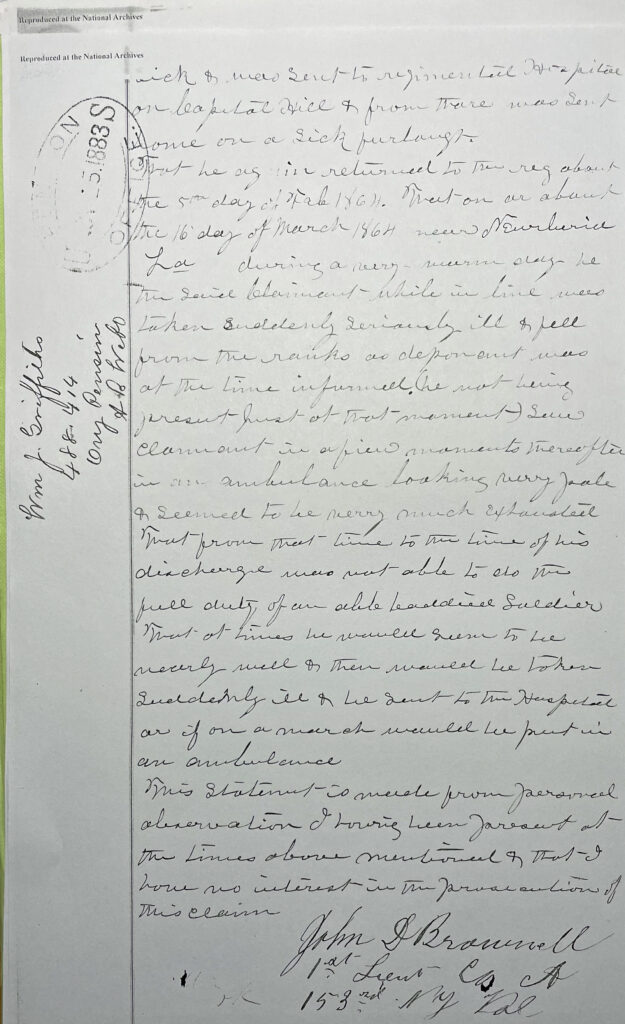
Page two of the affidavit from John Brownell which describes an incident where William Griffis succumbed to heatstroke during the march to Shreveport during the Red River Campaign
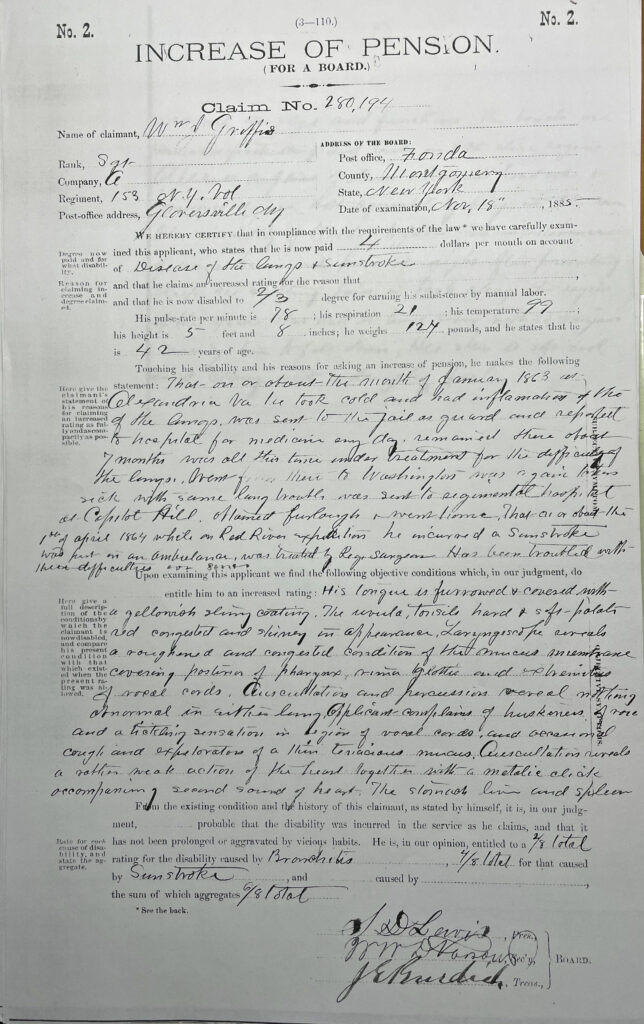
In an earlier pension request, Claim 280.194, it is indicated that “on about April 1 1864 while on Red River Expedition he incurred a sunstroke was put in an ambulance was treated by regimental surgeon has been troubled with difficulties ever since.”
[33] Beecher, Dr. Harris H., Record of the 114th Regiment, New York State Volunteer: Where it Went, What it Saw, and What it Did, Norwitch, NY: J.F. Hubbard, Jr., 1866, Page 293-294
[34] The 114th Infantry Regiment, New York State Military Museum and Veterans Research Center, NYS Division of Military and Naval Affairs, page last modified 31 Jul 2018, page accessed 6 Jan 2021.
[35] Beecher, Dr. Harris H., Record of the 114th Regiment, New York State Volunteer: Where it Went, What it Saw, and What it Did, Norwitch, NY: J.F. Hubbard, Jr., 1866, Page 294
[36] Pellet, Elias Porter, History of the 114th Regiment, New York State Volunteers, Norwich: Telegraph & Chronicle Power press, 1866, Page 188
[37] Ibid, Page 188-189
[38] Browning, Judkin and Timothy Silver, An Environmental History of the Civil War, Chapel Hill: The University of North Carolina Press, 2020, Pages 12-13
[39] Lackey, Rodney C., Notes on Civil War Logistics: Facts and Stories, United States Army Transportation Corps and Transportation School, Fort Lee, Virginiano date, Accessed December 15, 2020; Browning, Judkin and Timothy Silver, An Environmental History of the Civil War, Chapel Hill: The University of North Carolina Press, 2020, Pages 13
[40] Sherwoon, Lauralee, Human Physiology: From Cells to Systems, Belmont: Broos/Cole, Cengage Learning, 2013, Page 651
[41] Beecher, Dr. Harris H., Record of the 114th Regiment, New York State Volunteer: Where it Went, What it Saw, and What it Did, Norwitch, NY: J.F. Hubbard, Jr., 1866, Page 409
[42] Pellet, Elias Porter, History of the 114th Regiment, New York State Volunteers, Norwich: Telegraph & Chronicle Power press, 1866, Page 181-182
[43] Ibid, Page 188.
[44] O’Sullivan, Timothy H, photographer. Rappahannock Station, Va. Pontoon wagon, 50th New York Engineers. United States Virginia Rappahannock Station, 1864. March. Photograph. https://www.loc.gov/item/2018666375/.
[45] Pellet, Elias Porter, History of the 114th Regiment, New York State Volunteers, Norwich: Telegraph & Chronicle Power Press, 1866, Pages 189-190
[46] Clark, Orton, S., The 116th Regiment of New York State Volunteers, Buffalo: Mathew & Warren, 1868, Page 152 Also accessible on Google Books
[47] Ibid, Pages 154-155.
[48] War of the Rebellion: A compilation of the Official Records of the Union and Confederate Armies, prepared by Lieut. Col. Robert N. Scott, Series I, Volume 34, Part 1, Washington: Government Printing Offie, 1891, Page 227
[49] Beecher, Dr. Harris H., Record of the 114th Regiment, New York State Volunteer: Where it Went, What it Saw, and What it Did, Norwitch, NY: J.F. Hubbard, Jr., 1866, Page 312
[50] War of the Rebellion: A compilation of the Official Records of he Union and Confederate Armies, prepared by Lieut. Col. Robert N. Scott, Series I, Volume 34, Part 1, Washington: Government Printing Offie, 1891, Pages are reflected on each map page.
[51] Pellet, Elias Porter, History of the 114th Regiment, New York State Volunteers, Norwich: Telegraph & Chronicle Power Press, 1866, Page 213
[52] Beecher, Dr. Harris H., Record of the 114th Regiment, New York State Volunteer: Where it Went, What it Saw, and What it Did, Norwitch, NY: J.F. Hubbard, Jr., 1866, Page 324
[53] Clark, Orton, S., The 116th Regiment of New York State Volunteers, Buffalo: Mathew & Warren, 1868, Page 163
[54] Ibid, Page 167
[55] War of the Rebellion: A compilation of the Official Records of he Union and Confederate Armies, prepared by Lieut. Col. Robert N. Scott, Series I, Volume 34, Part 1, Washington: Government Printing Offie, 1891, Page 233
[56] Clark, Orton, S., The 116th Regiment of New York State Volunteers, Buffalo: Mathew & Warren, 1868, Pages 169-173
[56] Bailey, Col. Joseph (1826-1867), Wisconsin Civil War Officer, Lumberman, Wisconsin Historical Society, Page accessed Feb 23, 2021
[57] Building the Red River Dam. United States Red River Lousiana Texas, None. [Photographed between 1861 and 1865, printed between 1880 and 1889] Photograph. https://www.loc.gov/item/2013647498/ , Library of Congress, Civil War Glass Negatives and Related Prints
[58] Soodalter, Ron, Engineer’s Solution to Disaster: Dam the Red River, Full Speed Ahead, History.Net, September 2019; Bailey’s Dam, Wikipedia, Page was last edited on 23 Oct 2020, Page accessed 22 Feb 2021; Bailey’s Dam, American Battlefield Trust, Page accessed 23 Feb 2021
[59] Clark, Orton, S., The 116th Regiment of New York State Volunteers, Buffalo: Mathew & Warren, 1868, Pages 174-177
[60] War of the Rebellion: A compilation of the Official Records of he Union and Confederate Armies, prepared by Lieut. Col. Robert N. Scott, Series I, Volume 34, Part 1, Washington: Government Printing Offie, 1891, 234-235
[61] Pellet, Elias Porter, History of the 114th Regiment, New York State Volunteers, Norwich: Telegraph & Chronicle Power Press, 1866, Page 437
[62] Beecher, Dr. Harris H., Record of the 114th Regiment, New York State Volunteer: Where it Went, What it Saw, and What it Did, Norwitch, NY: J.F. Hubbard, Jr., 1866, Page 359
[63] Ibid, 367
[64] Ibid, Pages 370-371
[65] Ibid, Page 374
[66] Judge, Joseph (1994). Season of Fire: The Confederate Strike on Washington. Berryville, Virginia: Rockbridge Publishing Company,1994, Page 216
[67] Ibid, Page 219
[68] Cramer, John Henry (1948). Under Enemy Fire: The Complete Account of His Experiences During Early’s Attack on Washington. Pages 91-93
[69] Fort Stevens – July 11-12, 1864, American Battlefield Trust, March 2020, Page accessed Feb 14, 2021
[70] See Lionheart Film works https://www.lionheart-filmworks.com; Also their You Tube Channel: https://www.youtube.com/hashtag/lionheartfilmworks
[71] Beecher, Dr. Harris H., Record of the 114th Regiment, New York State Volunteer: Where it Went, What it Saw, and What it Did, Norwitch, NY: J.F. Hubbard, Jr., 1866, Page 381
[72] Ibid, Pages 381-382
[73] Ibid, Page 385
[74] Ibid, Page 387
[75] Ibid, Page 388
[76] Ibid, Page 390
[77] Ibid, Page 396
[78] Ibid, Page 398
[79] Civil War map of Virginia and West Virginia from the U.S. Coast Survey, Compiled by W[alter] L. Nicholson / Lith. by Cha[rle]s G. Krebs, Map of the State of Virginia, the Coast Survey Office. Washington: United States Coast Survey, October 1864
“An exceptionally detailed map of Virginia and West Virginia, prepared by the Coast Survey for the Union Army in October 1864. … This was the finest available map of the region, and copies would likely have been rushed to officers both at headquarters and in the field.”
[80] XIX Corps Civil War Facts, The American Civil War, Last Modified: 28 Feb 2021, Page accessed 1 Mar 2021 1
[81] Beecher, Dr. Harris H., Record of the 114th Regiment, Page 400
[82] Ibid, Page 401
[83] Ibid, Page 401-402
[84] Ibid, Page 402
[85] No 5 Reports of Lieut. Col. John S. Mosby, Forty-Third Virginia Calvary Battalion, HDQTRS 43rd Virginia Partisan Ranger Battalion to General Robert E. Lee, September 11, 1864, documented in Davis, George, Leslie Perry, Joseph Kirkley, Board of Publication, The War of the Rebellion: A Compilation of the Official Records of the Union and Confederate Armies, Published under the direction of Daniel Lamont, Secretary of War , Series I, Volume XLIII in Two Parts, Part I – Reports, Correspondence, Etc. , Washington: Government Printing Office, 1983, Page 633
[86] Ibid, Page 633
[87] Beecher, Dr. Harris H., Record of the 114th Regiment, Page 406
[88] Ibid, Page 416
[89] Patchan, Scott C. The Last Battle of Winchester: Phil Sheridan, Jubal Early, and the Shenandoah Valley Campaign, August 7–September 19, 1864, El Dorado Hills, CA: Savas Beatie, 2013 ; Wert, Jeffry D. From Winchester to Cedar Creek: The Shenandoah Campaign of 1864. New York: Simon & Schuster, 1987;
[90] Opequon Union order of battle, Wikipedia, Pages accessed was last edited on 9 Feb 2021;
The Dragoons were part of the Calvary Corps commanded by Brigadier General Alfred Torbert, First Division commanded by Brigadier General Wesley Merrit, 2nd Brigade commanded by Brigadier General Thomas Devin, the regiment was commanded by Colonel Alfred Gibbs.
The 153rd NY Infantry was part of the 19th Corp commanded by Brigadier General William Emory, First Division commanded by Brigadier Genera lWilliam Dwight, 1st Brigade commanded by Colonel George Beal and the regiment was commanded by Colonel Edwin Davis
[91] Irwin, Richard, History of the 19th Army Corps of the Union Army During the American Civil War, Leonaur imprint of Oakpast, Ltd, 2009, originating published 1892, Page 301;
[92 ] Beecher, Dr. Harris H., Record of the 114th Regiment, Page 420
[93] Noyales, Jonathan A., Battle of Fisher’s Hill, American Battlefield Trust, Page accessed 15 Feb 2021
[94] Stanley, Steven, Map of Battle of Fisher’s Hill, American Battlefield Trust, Page accessed 15 2021
[95] Noyales, Jonathan A., Battle of Fisher’s Hill, American Battlefield Trust, Page accessed 15 Feb 2021
[96] Mahr, Theodore C. The Battle of Cedar Creek: Showdown in the Shenandoah, October 1–30, 1864. Lynchburg, VA: H. E. Howard Inc., 1992.; Battle of Cedar Creek, Wikipedia, Accessed page was last edited on 6 February 2021.
[97] Grand Review of the Armies, Wikipedia, Accessed page waslast edited on 31 December 2020; D. Reid Ross, Civil War Grand Review, America’s Civil War, Vol. 28, No. 2 (May 2015); The “grand review” of the Union army held in Washington D.C., 1865, Library of Congress
[98] Claim of Amanda Griffis, Widows Pension, No. 885.963, U.S. Department of Interior, Bureau of Pensions, Washington D.C.


